
IRRIGATION TRAINING AND CAREER PATHWAYS
WINTER 2024 • VOLUME 40 NO 02
ISSN 0818–9447
IN THIS ISSUE:
MASSIVE IRRIGATION PROJECT FOR BUNBURY TURF CLUB, WA ELECTROFUSION FOR LONG-LASTING PIPEWORK
RURAL: Solar irrigation pays off for school farm IRRIGATION AUSTRALIA CONFERENCE AND EXHIBITION CASE STUDY: Stormwater harvesting project




DRIVEN SKIDS & TRAILERS

HWR SERIES









VORTEX SERIES
WET PRIME SERIES
VERTICAL TURBINES
SUBMERSIBLE MOTORS
END SUCTION CENTRIFUGAL
DRIVES & PROTECTION
CLEANWATER CENTRIFUGAL
VR SERIES
A comprehensive range of Auto Prime diesel packaged options for fixed and portable installations.
Wear-resistant pumps manufactured with high-chrome white iron to maximize resistance against destructive abrasives and maintain peak performance in light slurry applications.
A unique pumping solution that eliminates costly and disruptive downtime by passing through the most challenging solids using a recessed impeller.
Self-priming pumps designed for reliable solids and clear liquids handling. Continues to reprime automatically after initial priming.
Submersible turbine pumps available in custom configurations to meet demanding application requirements.
Our submersible motors are tough, built to last and come in a variety of construction options.
Close-coupled, electric motor driven pumps available in single or three-phase standard voltages to fit your site requirements.
Equip a Franklin drive to protect, monitor, and meet the different needs and demands of each application with the same pump.
Centrifugal pumps that feature heavy-duty ductile iron volutes, designed to handle tough applications with high efficiency.
Vertical multi-stage pumps are available in high- and low-speed models for superior durability, efficiency, and performance in a wide variety of applications.

106-110 Micro Circuit, Dandenong South, Victoria 3175 , Australia Toll Free: 1300 FRANKLIN / 1300 372 655 Fax: +61 3 9799 5050 Tel: +61 3 9799 5000 www.franklin-electric.com.au 67 Proximity Drive, Sunshine West Victoria 3020, Australia Phone +6 1 399881650 Fax: +61 39988 1666 www.pioneerpump.com


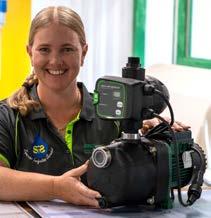
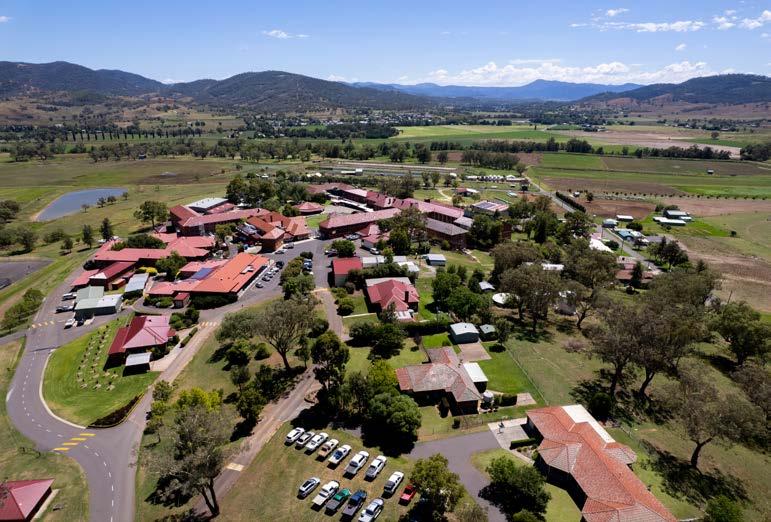

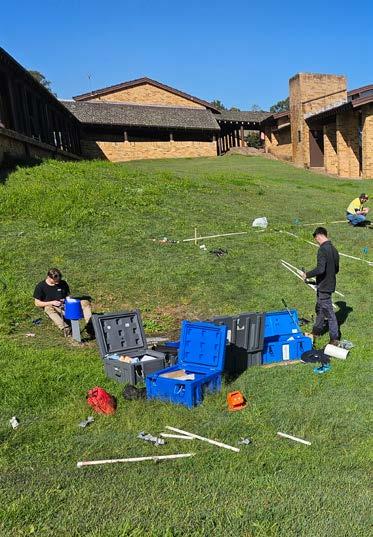
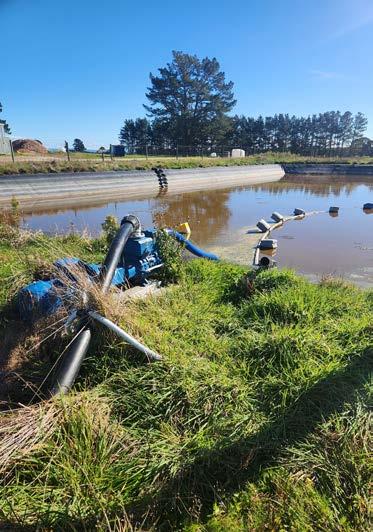
WINTER 2024 1 CONTENTS ON THE FRONT COVER: Natalie Morris, from Superior Irrigation Services in Gatton, has had an interesting career path from teaching to irrigation. Page 37. IN THIS ISSUE: ISSN 0818–9447 IRRIGATION TRAINING AND CAREER PATHWAYS RURAL: Solar irrigation pays off for school farm IRRIGATION AUSTRALIA CONFERENCE AND EXHIBITION CASE STUDY: Stormwater harvesting project 16 40 36 4 ALTERNATIVE WATER SOURCES FEATURE Case study: Irrigating with stormwater saves mains water and reduces pollution 14 Three questions to ask when designing a rainwater harvesting system 16 Desalination for agriculture – benefits and challenges 19 PROFESSIONAL DEVELOPMENT FEATURE Map out your own career path – certifications and short courses to suit everyone 24 Meet the trainer: Luke Cummins 26 FEATURE ARTICLES Irrigation Australia Conference and Exhibition: a preview 28 Staying in Sydney after the conference? Here are some must-see attractions 30 Irrigation for safety and animal welfare at greyhound racing club 38 Inconsistent state laws lead to dropped water theft cases 39 Technology for effluent irrigation: helping dairy farmers make informed decisions 40 FEATURES Joint message from the Chair and CEO 2 Technology: Rural 4 Technology: Urban 8 Research 12 The Big Issue 20 IAL News 33 Professional Development 36 ICID Insights 42 Business Feature 44 The Water Conservancy 46 State Roundup 47 Contractors' Corner 48 Around Industry 50 REGULAR ITEMS
WELCOME

JOINT MESSAGE FROM THE CHAIR AND CEO
Welcome to the 2024 winter edition of the journal. We’re currently in the final throes of conference preparation and gearing up to welcome a large contingent of national and international visitors to Sydney. We hope to see as many Irrigation Australia members as can make it. Remember, this event only exists because of the investment of our sponsors and exhibitors – we need your support to continue to be able to offer these critical networking and knowledge exchange opportunities.
At recent board meetings, we’ve focussed on budget planning and end of financial year results for the association, as it has navigated a significant period of change, including new personnel. We’ve seen some significant achievements – 2024 is not only a big conference year but an audit year for our registered training organisation.
Recent achievements
Some recent highlights include:
• onboarding of critical new staff in the training team
• completing an internal RTO audit, facilitated by a third party, in preparation for the big one
• a huge review of course materials, including certification programs
• developing a complete 2024/25 training calendar – the last step in being able to assure students and employers of suitable notice periods for changes and address past scheduling challenges
• implementing new communications/marketing software and allocating a near full-time resource to improving the way we engage with members and others through social media and other channels
• commencing our new policy committee to help drive a national advocacy approach. We have also held meetings with regional committees in Queensland and South Australia to inform that advocacy program and plan member engagement opportunities. We intend to pick up other regions later in the year, being careful not to bite off more than we can chew
• release of the new Waterwise website.

Next steps
Coming up, our key activities will include:
• finalising the constitution review. You will have opportunities to ask questions about the modest but necessary proposed amendments
• rationalising the certification programs to develop a more targeted approach
• gradually introducing more online learning pathways
• planning to celebrate 20 years of Waterwise in Western Australia
• a member recognition/accreditation program, beyond the awards mentioned below
• developing a new main website and careers site.
A spotlight on training
In response to market feedback, we’ve refocussed on some shorter courses for our new training calendar. These include Certified Irrigation Installer and Certified Irrigation Operator. Of course, there’d be no training without our excellent trainers. In this issue of the journal, you can read the first in a series of profiles of our trainers. Luke Cummins is first cab off the rank, featured on page 26.
We’re always on the lookout for more trainers with strong industry experience and who are keen to pass this knowledge on. If this describes you and you would like to become a contractor with Irrigation Australia, get in touch.
Conference and exhibition highlights
If you’re heading to Sydney in September, here’s what you can expect at the conference and exhibition.
At the time of writing, at the conference, we have:
• thirty-eight speaking presentations, thirty-two posters and related short presentations. The presentations have ended up being almost equally split among the sub-themes of Governance, Investment and Capacity Development
• four major keynotes
• three planned panel sessions, including Women in Water/ Irrigation, Young Professionals, and a stimulating panel discussion around the benefits of irrigated agriculture
• some exciting and fun entertainment/social activities, including our major dinner
2
• around 10 significant workshops, in addition to ICID workshop activities. The workshop topics include certification, metering, rainwater harvesting, Sydney Water and local government training, urban irrigation/utility partnerships, environment and more. We are pleased to be welcoming school students for a large part of 4 September to hear about careers in the industry and to visit the exhibition
• a Q&A session with Irrigation Australia management. This is an opportunity to directly tell us what you think about our priorities and continuous improvement plan to build our member value proposition.
We are particularly keen to encourage as many end-users as possible to attend the event, including growers and open space managers and operators. We hope that members can help spread the message.
The exhibition will have some notable differences from the last major event in Adelaide. At the time of writing:
• around 70 per cent of available space is sold and the floorplan is regularly updated here
• in response to feedback from the Adelaide event, we originally planned to limit public attendance to specific sessions at the exhibition. However, following more recent feedback, we have decided that it will be open for the full three days.
• all delegate meals will be held in the exhibition area, close to exhibitors, to encourage interaction
• an interactive zone will be set up for product demonstrations throughout the exhibition, and we will have a networking lounge in the middle
• the conference poster display is set up as part of the exhibition and the poster presentations mentioned above will be made during extended (two-hour) lunch breaks
• we are planning other activities for the exhibition area, including best display competitions, ‘treasure hunt’ type competitions for delegates, to encourage visits to booths, a pipe robot building competition and so on.
Remember this is the last conference of this style and scale – let’s make it a great industry celebration.
Awards
On that theme, we’ve finally released our guidelines for new industry awards, to be presented at the conference. This is a trial year and we may adjust criteria based on further feedback and interest, but to start, check this out.
The new categories are:
• Water Efficiency Management Awards – categories for individuals, small businesses and large businesses
• Innovation in Sustainability Awards – categories for individuals, small businesses and large businesses
• Emerging Leader Award – one individual
• Innovation in Safety Awards – categories for individuals, small businesses and large businesses.
To be eligible, the individual or organisation must be a current financial Irrigation Australia member, and the nomination process couldn’t be simpler: just answer a few questions and we’ll be in touch for an interview so we can provide information to the judges.
Don’t forget to nominate Life Members, and members for the prestigious MacLean-Iedema Award. At the time of writing, we had not received any nominations.
Go Stuart!
Speaking of awards, congratulations to Stuart Alexander for being recognised as one of three finalists in the Queensland Training Awards for the Trainer of the Year category. While it might be badged ‘Queensland’, Stuart delivers nationally. You just have to start somewhere on your way to world domination.
The recognition will be of no surprise to his many students, but this is about more than just training – he’s a bloke who has fundamentally changed the way Irrigation Australia approaches student management, safety, and particularly our approach to the mental health of all.
Stay tuned to find out the results. Best of luck, Stuart.
Simon Treptow, Chair
Dave Cameron, CEO
WINTER 2024 3
TECHNOLOGY: RURAL
SOLAR IRRIGATION PAYS OFF FOR AGRICULTURAL SCHOOL FARM
SNAPSHOT
• An agricultural school near Tamworth, NSW, has installed electric irrigation pumps and a raised single axis solar photovoltaics (PV) tracking system on the school farm.
• The tracking system for the PV generates 24 per cent more energy than an equivalently sized rooftopmounted system.
• The raised PV system means farmland can be used for power generation while cattle to graze around it, without sacrificing productive land.
• The project, which was part of a pilot study by NSW DPI, cost $380,000 with a payback period of three years. NSW DPI contributed 50 per cent of the project costs.
• The farm managers have seen many benefits including reduced costs in energy, and reduced labour and maintenance.
An agricultural school near Tamworth, NSW, has installed electric irrigation pumps and a raised single axis solar photovoltaics tracking system on the school farm. The work was done as part of a NSW DPI pilot project to improve on-farm efficiency. The farm manager says the benefits for the farm have been huge, including energy
and emissions savings, and reduced labour, which frees up staff to focus on other tasks.
Established in 1939, Farrer Memorial Agricultural High School is a public agricultural secondary school. The Farrer campus is set on 191 ha and is located at Calala on the outskirts of Tamworth.
Farrer Farm is part of Farrer Memorial Agricultural High School, and assets include a 170 ha farm, horticultural centre and piggery. Dairy cattle, sheep and an Angus cattle stud are run on the farm. The largest use of energy at Farrer Farm is for powering irrigation pumps to grow hay and silage.
Short payback time for agrivoltaics system
The school was recently chosen as a demonstration site as part of the NSW DPI Energy Efficiency Solutions Project.
The work involved electrifying the irrigation pumps (diesel to electric) and installing a 60 kW raised single-axis solar photovoltaic (PV) tracking system to power the irrigation pumps.
The raised PV system allows farmland to be used for power generation while supporting agricultural production – a concept commonly referred to as agrivoltaics. The PV framework is structurally reinforced, allowing cattle to be colocated in the same paddock as the PV system.
The total cost of the project was approximately $380,000 with a payback of about three years.
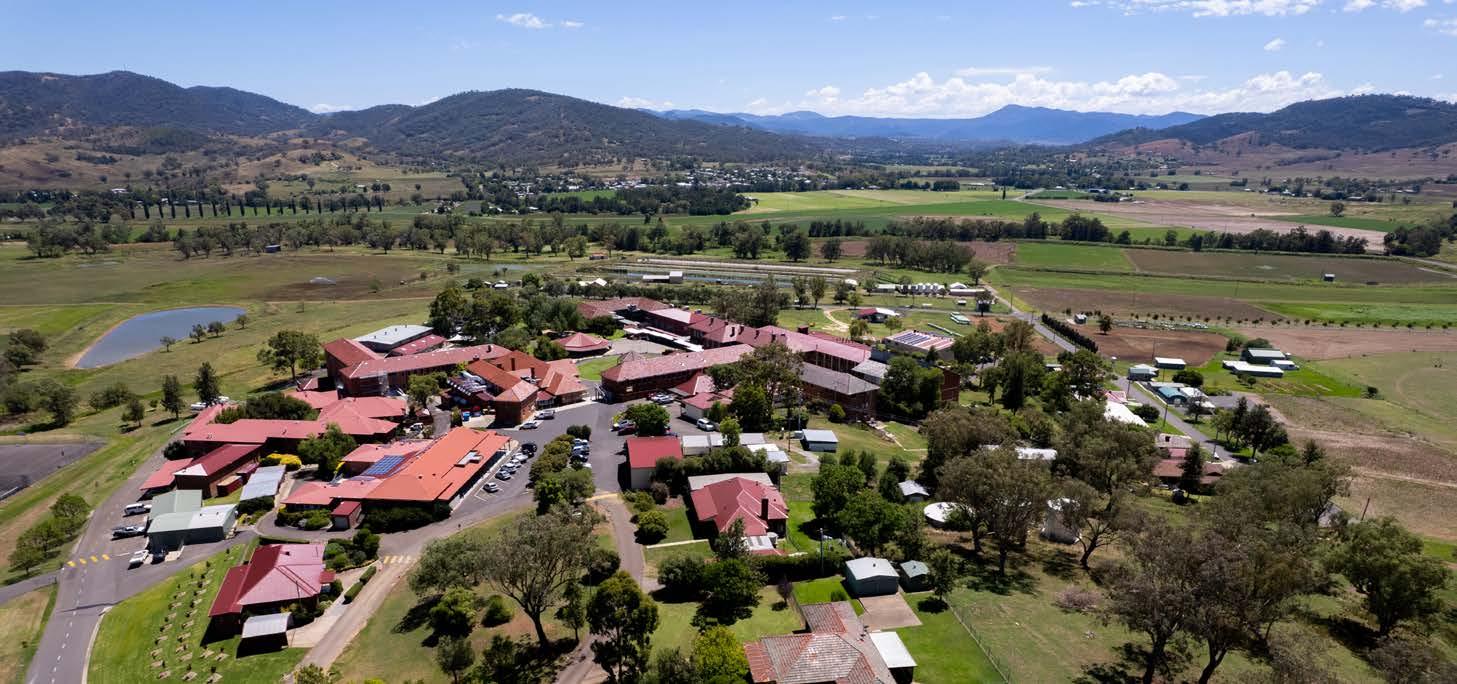
Farrer Memorial Agricultural High School is one of eight sites that have participated in a pilot project with NSW DPI. The Energy Efficiency Solutions Project aims to demonstrate innovative technologies and practices to improve on-farm energy efficiency, energy security and productivity while reducing on-farm energy use, costs and emissions.
4
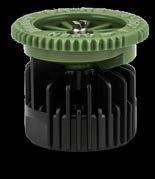
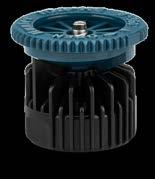

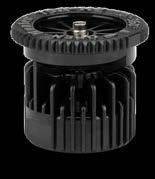
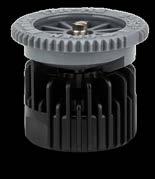
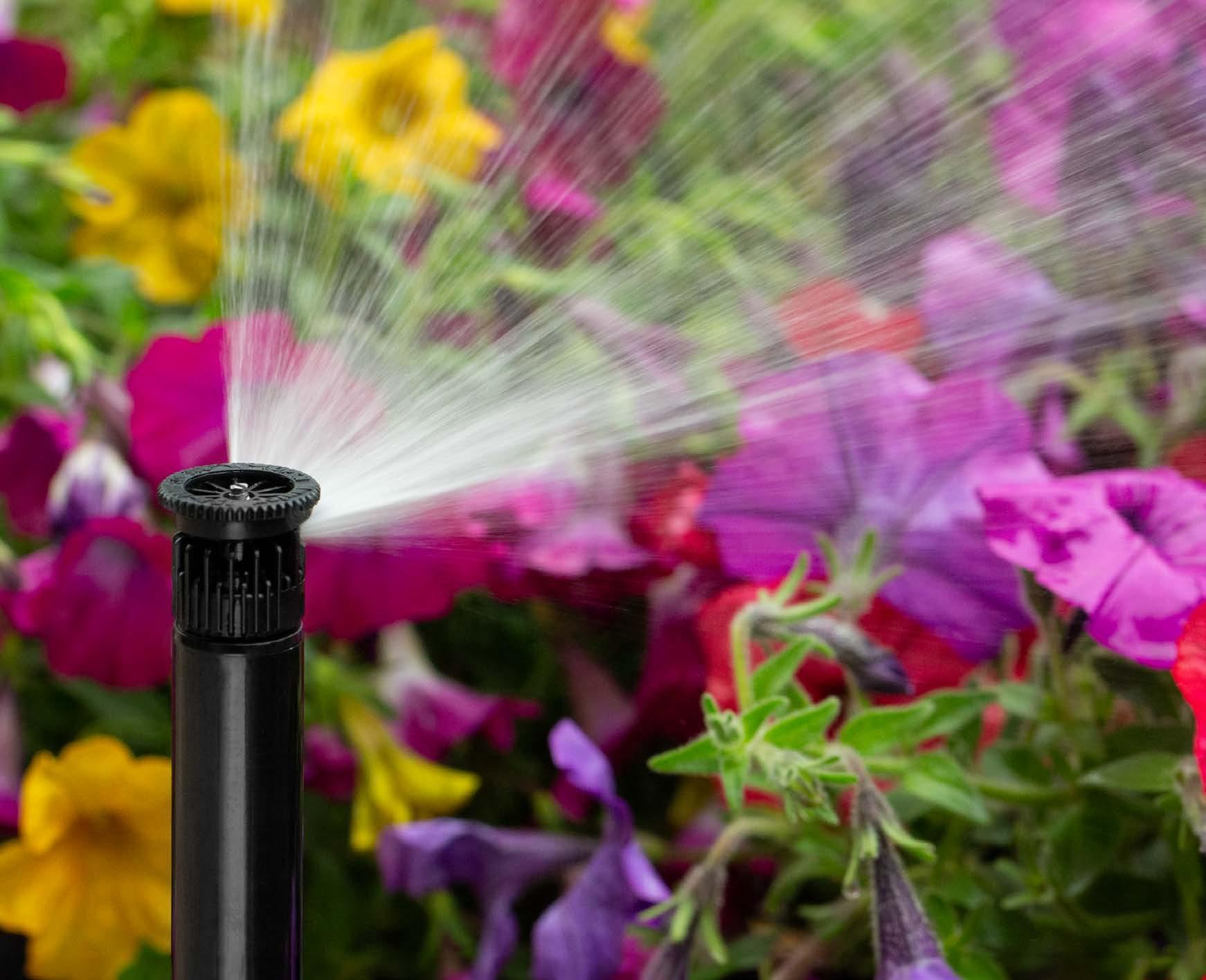
UNIFORMITY UNLEASHED

RESIDENTIAL & COMMERCIAL IRRIGATION | Built on Innovation® Learn more. Visit hunterindustries.com A NEW MODEL OF EFFICIENCY
matched
line
mixing
saving water.
targeted
high-uniform
National Free Call: 1 800 HUNTER Toll Free Fax: 1 800 651 680 www.hrproducts.com.au hrsales@hrproducts.com.au Tel: 1 300 856 368 Fax: 1 300 856 369 www.nelsonirrigation.com.au info@nelsonirrigation.com.au Suite 7, 202 Ferntree Gully Road, Notting Hill, Melbourne, Victoria, 3168, Australia Tel: 61 3 9562 9918 Fax: 61 3 9558 6983
Achieve higher uniformity with new Pro High-Efficiency Nozzles! Designed for easy installation and long-lasting performance, these robust spray nozzles offer
precipitation across the
for easy
and matching on zones while
For
water delivery from a
spray pattern, say hello to a new model of irrigation efficiency.
TECHNOLOGY: RURAL

The PV framework is structurally reinforced, allowing cattle to be co-located in the same paddock as the PV system.
Less labour and more control over irrigation
As well as significantly reducing energy costs and carbon emissions, the new system has reduced labour.
Farm Manager Andrew Eather said that the existing diesel pumping system was old and inefficient. It required manual labour for filling tanks, operational inspections, and both external and internal labour for maintenance of the diesel engines.
The total cost of the project was approximately $380,000 with a payback of about three years.
Andrew noted, “In the past we had machines that have overheated in the summer and you’re going out and starting them late at night to try to get them running. You call that irritation, not irrigation.”
Eliminating labour required for diesel pump maintenance has reduced labour costs and freed up farm staff time to work on higher value tasks such irrigation optimisation, data analysis and teaching students how to optimise irrigation systems.
Electrification of irrigation pumps has also provided the farm with greater control of their irrigation system through the AgSense irrigation management control system. This enables farm managers to optimise and potentially automate irrigation schedules to manage flow rates and increase water efficiency. The irrigation system is remotely controlled using a phone app.
The farm no longer requires diesel deliveries to the irrigation pumps, avoiding compaction of the soil and the risk of weeds being brought in by tankers.
The tracking system for the PV generates 24 per cent more energy than an equivalently sized rooftop-mounted system.
The way of the future
The project has introduced students to new technologies and this knowledge is being disseminated into the wider community via the school and its students.
Andrew said, “Not everyone wants to be the guinea pig –the first one up. But it's quite exciting in a way to try to lead the way and go, well, this is potentially the new future”.
Acknowledgment. This article is reprinted, with minor amendments, from the NSW Government website under a Creative Commons Attribution 4.0 Licence. © State of New South Wales. For current information go to www.nsw.gov.au
About the NSW DPI Energy Efficiency Solutions Project. The NSW DPI Energy Efficiency Solutions Project implemented seven pilot projects across eight sites to demonstrate innovative technologies and practices to improve on-farm energy efficiency, energy security and productivity while reducing on-farm energy use, costs and emissions. A rigorous evaluation process was undertaken to select proponents to participate in the pilot projects, with NSW DPI contributing 50 per cent of total project costs.
For more information about this project, take a brief tour of the farm with Farm Manager Andrew Eather in this video.
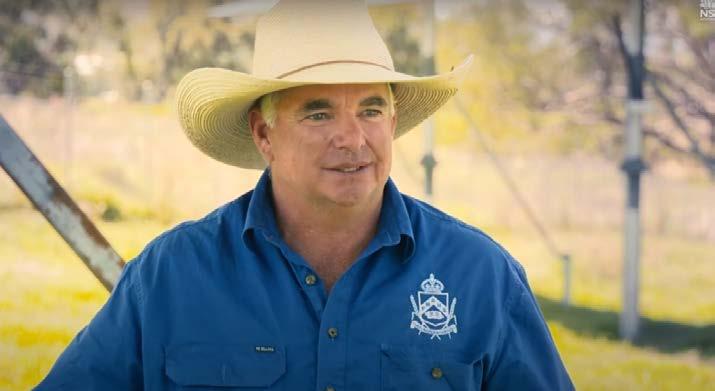
6

TECHNOLOGY: URBAN
CASE STUDY: MASSIVE IRRIGATION
UPGRADE FOR BUNBURY TURF CLUB
SNAPSHOT
• Bunbury Turf Club in Western Australia undertook a $25 million project, including a new irrigation system and drainage, to enable year-round racing.
• The irrigation design was completed by Ben Chapman from Water Equipment Technology, with installation by Think Water Bunbury.
• The project involved raising the tracks by a metre, constructing a new 20 m wide all-weather-turf course, a 17 m wide sand/fibre training track, and installing a new automated irrigation system.
• The installation was conducted in five stages over six months, starting with a new bore and focusing on different zones of the tracks.
• The new system included a 45 L/sec pump unit, a self-clean filter, a water meter, a dosing pump for fertigation, and 250 sprinklers for the grass track.
• The upgrade is expected to allow nearly 300 additional horses to train at the club and generate $36.2 million in direct expenditure for the local region annually by 2029.
Bunbury Turf Club in Western Australia recently undertook a major project, including a new irrigation system and drainage, to enable yearround racing. The irrigation design was completed by Ben Chapman from Water Equipment Technology, and the installation by Think Water Bunbury. This article describes the irrigation design and installation for this huge $25 million project.
Bunbury Turf Club is one of the largest provincial race clubs in WA and is strategically important for the industry’s sustainability and growth. It is the biggest training hub outside of Perth and supports the livelihood of some 70 trainers.
The club’s managers had long held ambitions of yearround racing, but winter flooding due to a high water table restricted the season to six months of the year, and significant work was needed to overcome this problem.
Alex Doble, club manager, explained, “Our key objective was to transform the venue into a year-round racetrack. Irrigation is obviously a critical element of our operation, and having a fully automated efficient irrigation system is key for us. “Just as important is looking after our local participants. We were in dire need of upgraded training facilities.”

8
The time came to undertake this work in 2021. By this point, the infrastructure was aging, and both the tracks and the irrigation system needed upgrades. This was no mean feat, because to get away from the water table, the tracks first had to be raised by a metre in height. The scale of the project meant that the racetrack had to be closed for a full season.
The project included the construction of a new 20 m wide all-weather-turf course proper, a new 17 m wide sand/ fibre training track, new drainage across both tracks, a new automated irrigation system across all tracks, and new horse stalls.
“Just as important is looking after our local participants. We were in dire need of upgraded training facilities.”
Installation in five stages
The work began with the construction of a new bore in November 2021, and continued through to October 2022. Michael Sanders from Think Water Bunbury explained that the team tackled the installation in five stages. The first four stages focussed on the main grass track, which was divided into four quadrants, or zones, that were worked on sequentially. The fifth involved installing the system for the sand fibre track.
For each stage of the grass track, the top layer of the previous grass track was removed, the new irrigation system installed, and the new layer of grass was then put down over the top. Each zone was completed with sprinklers operational via the control system before the team moved on to the next zone. This allowed the sprinklers to be used for dust suppression during construction. The work on the five zones were completed over six months.
Some 4,500 m of 125 mm PE mainline was needed for the inside and outside of the main grass track, and 1,700 m of 110 mm PE mainline for the inside of the sand fibre track. For each zone for both grass and sand tracks, the team took the following steps before moving on to the next zone:
• used an excavator to dig approximately 400 to 600 m long trench on the outside of the track.
• installed mainline pipe and welded pipe together.
• installed the control cable then sprinkler assemblies.
• pressure-tested the system to test for leaks, then ran sprinklers manually to check they were operational.
• connected control cable to sprinkler assemblies and tested for correct operation.
• backfilled the trench.
• tested the sprinklers via the controller.
This process was the repeated for the inside of track on same zone before moving on to the next zone and running through the same process.
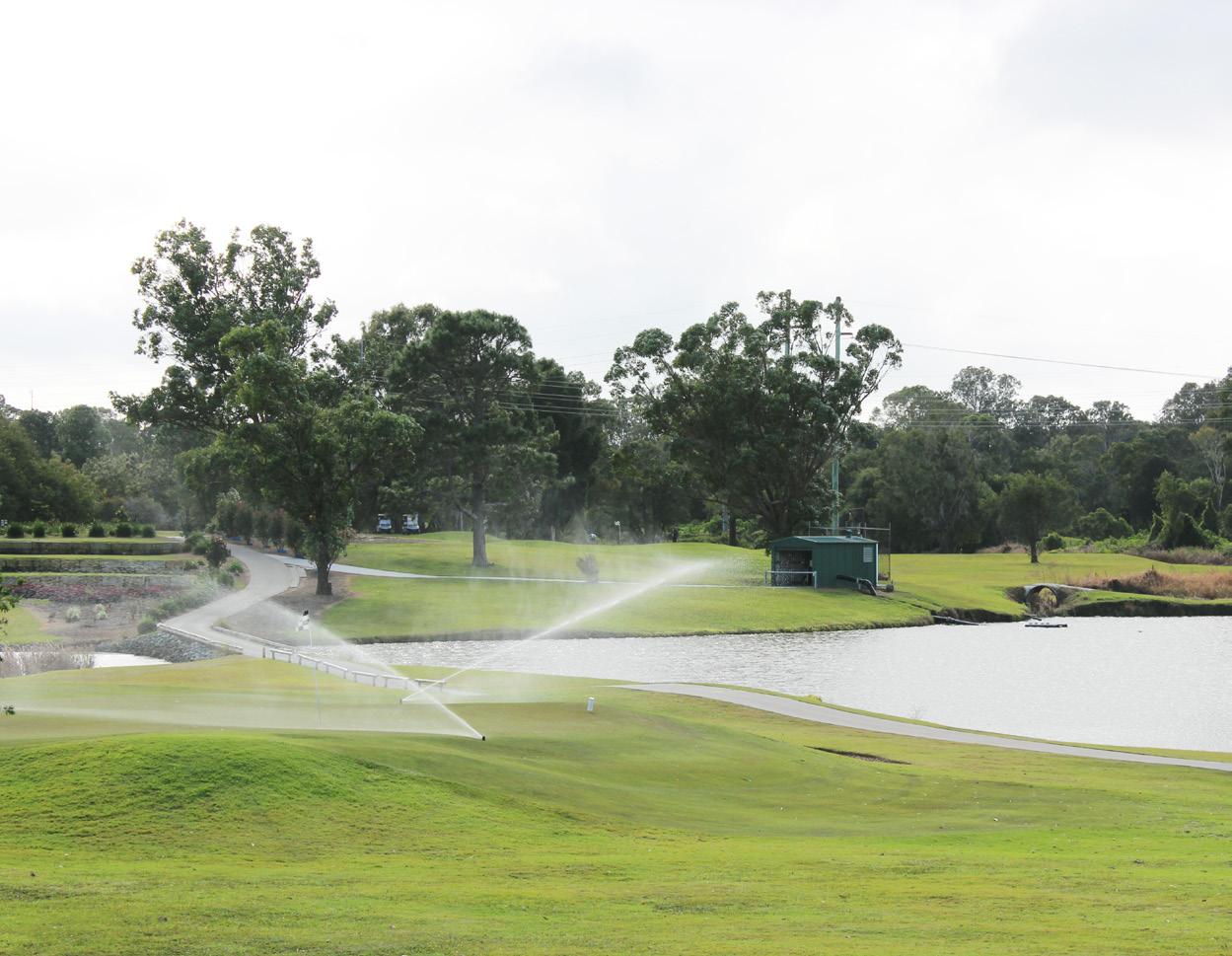

Add flexibility to your water demands.
Brown Brothers Engineers Custom Irrigation Systems

Featuring Lowara pumps and a custom control system for your technical specifications.
Create a booster station engineered to your individual application requirements.
• Maintain constant pressure
• Optimized pump efficiencies
• Longer lifetime and reduced lifecyle costs
• Water Supply
• Pressure Boosting
• Irrigation
• Water Treatment Suitable for:

Lowara’s extensive pump range together with our large selection of custom control options, offer a complete line of booster systems ideally suited for the diverse requirements of irrigation.
Contact us today to see how Lowara’s pump range and our custom engineering capabilities can assist with your water requirements.
DELIVERING PUMPING SOLUTIONS Ph: 1300 4 BBENG www.brownbros.com.au
06/24
TECHNOLOGY: URBAN
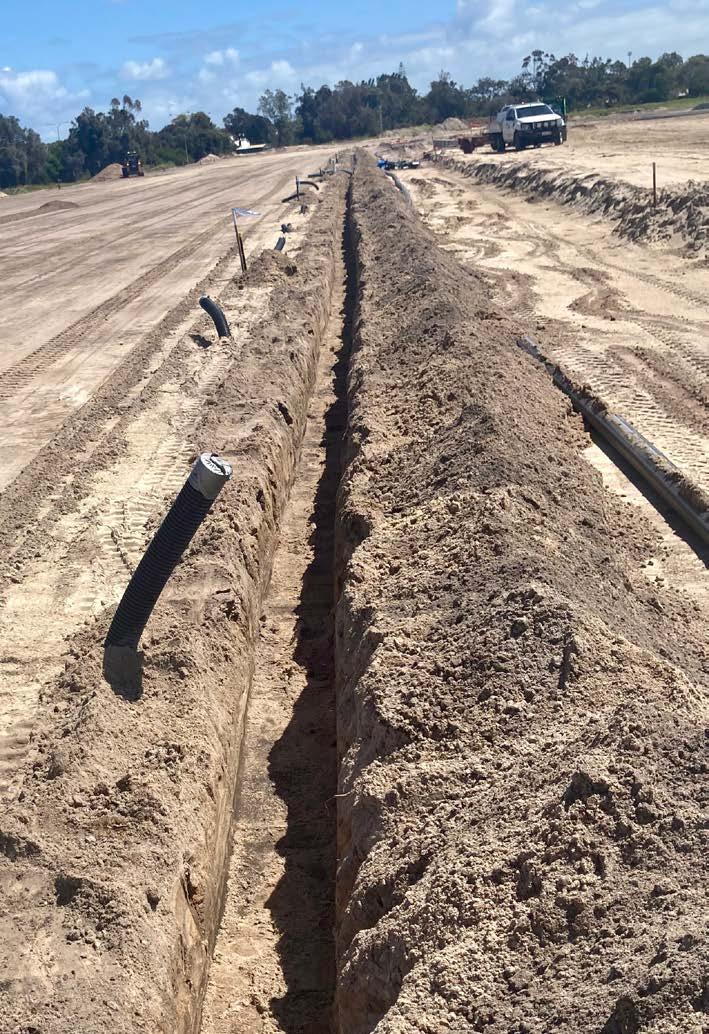
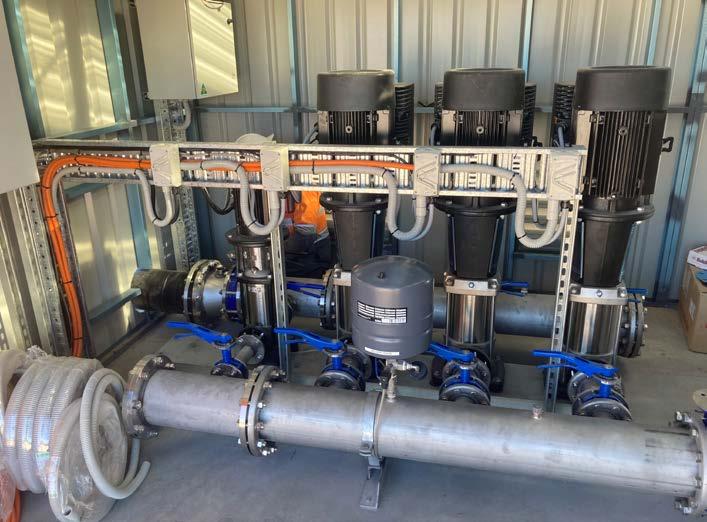
Pump shed
While the installation was underway, the old pump shed was decommissioned and a replacement constructed. Within the pump shed, the team installed:
• a 45 L/sec Grundfos Hydro MPC Pump unit with three main pumps and one jacking pump. The system included variable frequency drives.
• a Filtaworx 150 mm fully automatic self-clean filter
• a 150 mm Magflo water meter
• a Grundfos DDA dosing pump for fertigation
• a Rainbird Stratus 2, two-wire control system, which will eventually be moved to another location as directed by Turf Club.
Sprinklers
Irrigation designer Ben Chapman explained, “It’s critical that racetracks perform well in wet conditions. Many are constructed with sand, which obviously drains fast, so the irrigation system needs to be spot on. Irrigation uniformity is critical, not only to ensure even turf growth and health but also to set a constant soil moisture level for horse safety.”
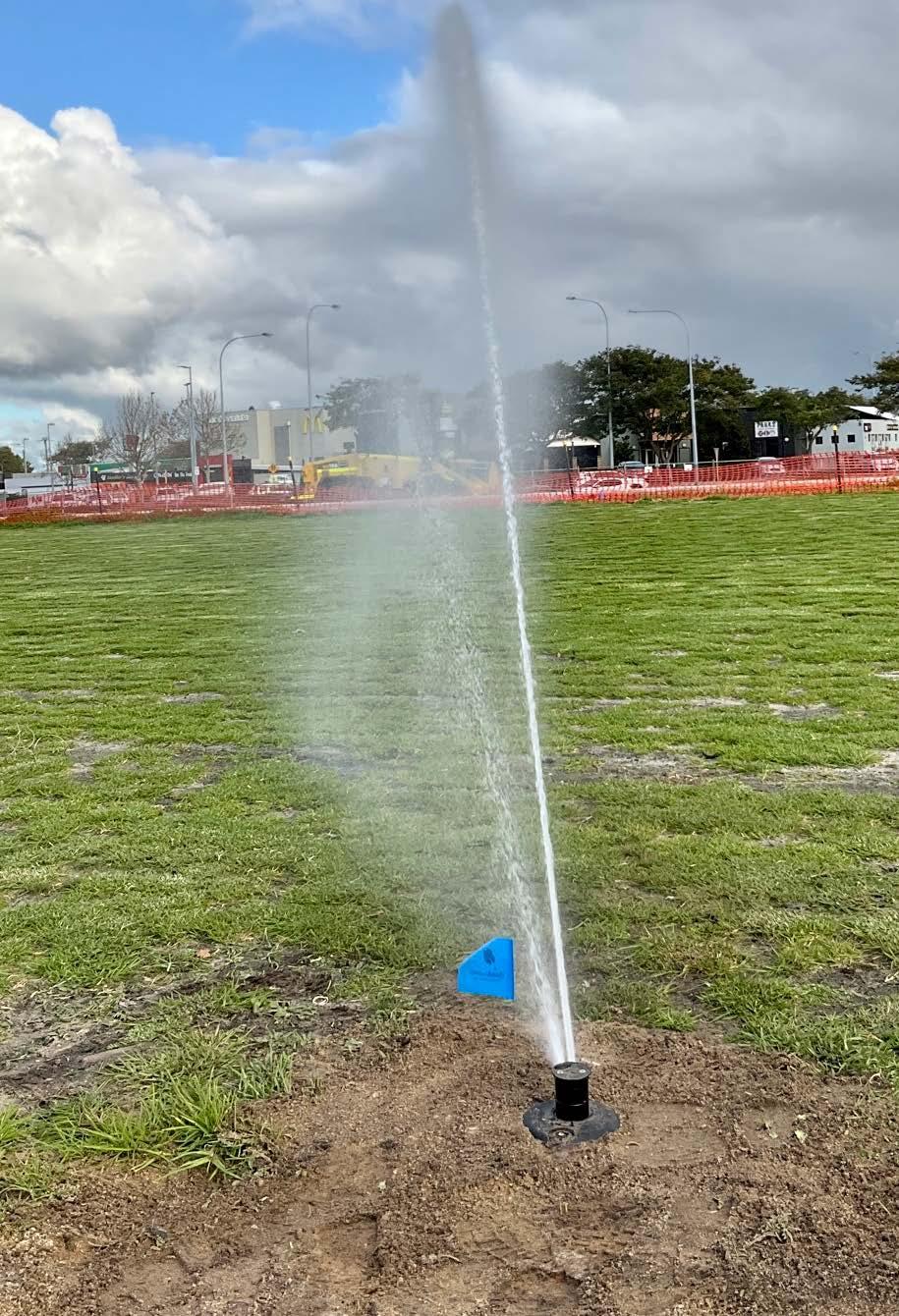

10
TOP: For each zone, the first step in the process was to excavate a trench of between 400 m and 600 m long on the outside of the track.
ABOVE: The work included a new pump shed and pump set.
RIGHT: For the grass track, 250 Rain Bird Eagle 950 valve-in-head sprinklers were installed under the rail on the inside and outside rails, with the back of the sprinkler in line with the rail posts.
While many tracks are irrigated from the inside rail only, Ben says that newer tracks are irrigated from both the inside and outside rail, which maximises uniformity and keeps the water in the profile; this is the approach that Ben used for Bunbury.
For the grass track, 250 Rain Bird Eagle 950 valve-in-head sprinklers were installed under the rail on the inside and outside rails, with the back of the sprinkler in line with the rail posts.
Some 200 Rainbird 8005 Sprinklers were installed in a single row on the sand fibre track. This track requires consistent dampness due to the nature of the sand that it’s constructed from as well as to prevent excessive dust.
The system is designed to apply 12 mm in eight hours, with a coefficient of uniformity of less than 1.2, a scheduled coefficient of better than 85 per cent, and a distribution uniformity of better than 80 per cent.
Issues and lessons learnt
Michael said that one minor issue they encountered during the project was the need to retain the old pumps for dust suppression while the work was being undertaken.
“Being able to decommission existing pumps prior to installation of new pumps is the most straightforward and efficient method of working. In the case of the turf club, due to the issue of dust suppression, we were unable to decommission the old pumps until after the installation of the new pumps. While not a major issue, this did cause slight delays and adjustments to our usual method of working.”
Delays were also caused by parts being unavailable.
Michael said, “There were still logistical issues from COVID as well as natural disasters that caused delays that meant we couldn’t meet the initial estimated completion dates.
“This also created additional labour as we had to make decisions about either working around not having parts or materials until a later date, or having to source them from other suppliers.”
According to Michael, this is one of the largest projects he has worked on. “It was a new experience in learning how to communicate when there are multiple companies and contractors involved in a large-scale project.”
The outcome
The irrigation system has been operating for 18 months and the track staff are happy with it. Club manager Alex said that while there were some initial maintenance challenges that needed to be ironed out, the system is now running smoothly, and the uniformity is impressive.
Alex said, “The system's efficiency is far superior to the previous set-up, and the uniformity is unbelievable”.
Alex noted that the system is relatively straightforward to use, but the staff also enjoy aspects of its complexity.
“We have various irrigation programs set to various weather occurrences, chiefly around wind direction. We also benefit from the data from the integrated weather system. The labour savings are significant and free up staff to complete other duties,” Alex said.
The project is expected to have flow-on effects too. An economic study by Racing and Wagering Western Australia forecast that by the 2029 financial year, the project will produce $36.2 million in direct expenditure for the local region each year. It is also predicted to sustain 253 full-time-equivalent roles.
Acknowledgment. This article was originally published in The Overflow

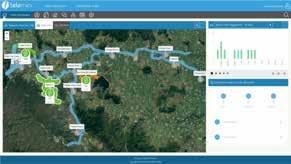


Cloud-based CRM & Demand Management for Australian Irrigation Schemes

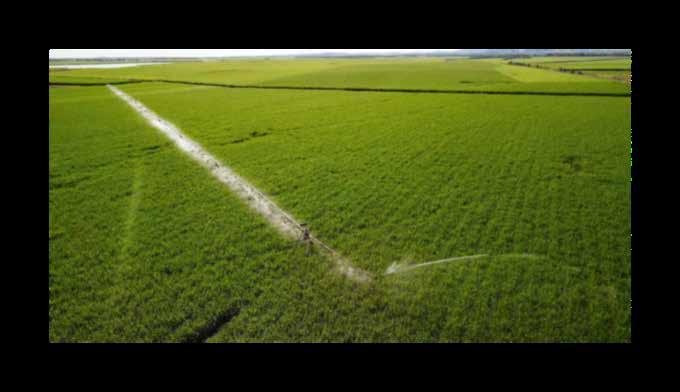
Secure management of customer records, allocations, transfers & metering
and responsive network modelling automates water delivery from orders
customer portal & mobile app
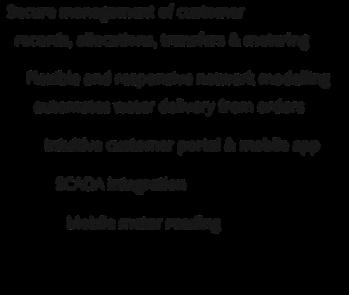

Eve White, Irrigation Australia TAKE CONTROL OF YOUR IRRIGATION SCHEME
Intuitive
SCADA
Mobile meter
Flexible
integration
reading
IRRIGATION BEHAVIOURS OF WINE GRAPE GROWERS
SNAPSHOT
• Researchers from the University of Tasmania interviewed wine grape growers in NSW, SA, Tasmania and Victoria about what irrigation methods and technologies they are using.
• To grape growers, water use efficiency generally means obtaining a financial return on irrigation.
• Most growers use visual observations to assess vine conditions for irrigation scheduling.
• Soil moisture levels are measured using soil sensors or by digging and visual assessment. However, about 40 per cent of growers feel soil sensors have limited value due to spatial variability in land.
• Water shortages, higher irrigation needs and higher costs for irrigation are growers’ main concerns about the impact of a changing climate.
• Having an understanding of grower’s attitudes, experiences and current irrigation practices will help guide technology development and promote wise water use.
In our changing climate, wine grape growers are facing the challenges of decreasing water availability and increasing irrigation needs. Growers will need to manage water wisely to ensure long-term supply of good-quality fruit. Many irrigation tools and technologies are available, but adoption rates of technologies like soil sensors are low – as low as 20 per cent in some regions.
Growers are under increasing pressure to manage water wisely to ensure long-term supply of good-quality fruit.
To promote wise water use and guide the development of new technologies and methods, we need to understand what irrigation practices growers are currently using, and why.
To answer these questions, researchers from the University of Tasmania recently interviewed 32 growers from NSW, SA, Tasmania, and Victoria. They asked questions about production goals, water sources, irrigation methods and scheduling, and associated issues. They also examined growers' perceptions of future climate conditions and their plans to adapt. The findings were published in a new report Irrigation behaviours of wine grape growers , produced for the TAS Farm Innovation Hub.
What the study found
Growers mainly irrigate to achieve desired grape composition, ensure consistent yields, and maintain vine health. Growers see water use efficiency as obtaining a financial return on irrigation and greater profitability, while also addressing limited water availability, high irrigation costs, and environmental protection. All the growers use drip irrigation, and the main issue associated with this is high maintenance needs.
Key pieces of information that growers use to decide when and where to irrigate include weather conditions, knowledge of crop water requirements, soil moisture levels and experience. Other considerations are vine growth stages, soil types, grape varieties, production goals, topography, irrigation system capabilities, and water availability. When water access is limited, market value of the fruit also influences decisions.

12 RESEARCH
Photo: mythja / Deposit Photos.
The new report looks at what irrigation practices wine grape growers are currently using, and why. This information will be useful to help guide development of new technologies and methods and to promote wise water use.
kwest / Deposit Photos.
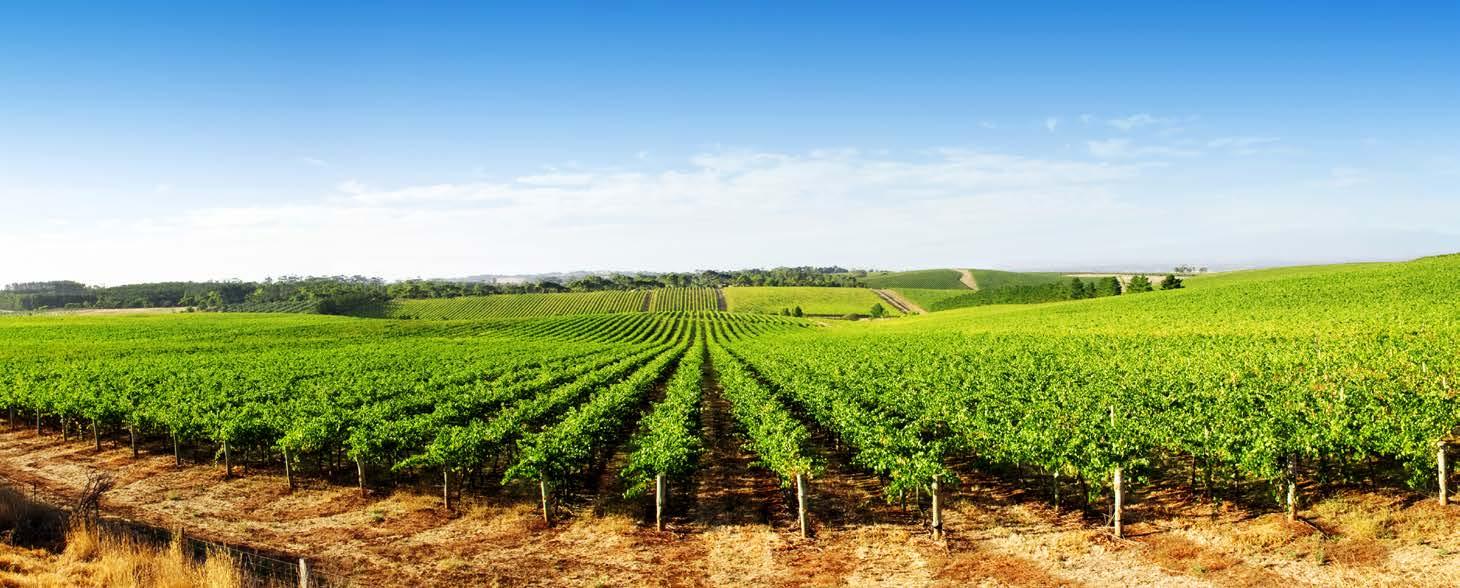
Most growers use visual observations to assess vine conditions for irrigation scheduling. Soil moisture levels are measured using soil sensors or by digging and visual assessment. Some growers don't adopt soil sensors because they rely on their experience. About 40 per cent of growers feel soil sensors have limited value due to spatial variability in land. The key issue is that information from one sensor is relevant to a small area of vines rather than the total area under management given spatial variability in land.
Growers generally expect more extreme and variable weather in the future, making reliable forecasting difficult. A few growers noted that rainfall patterns are being disrupted, leading to precipitation at times when vines may not need water. Water shortages, higher irrigation needs and higher costs for irrigation are growers’ main concerns about the impact of a changing climate.
Many growers are improving water security by finding new water sources, preserving soil moisture, and upgrading irrigation systems. Better irrigation technologies and support for their adoption are needed, though market issues may limit investment. Growers also noted that small businesses might need different technologies than large ones.
Acknowledgment. This is an edited excerpt from: Song X and Evans KJ (2024) Irrigation behaviours of wine grape growers in Australia. University of Tasmania Technical Report for the TAS Farm Innovation Hub. The study was funded by the Australian Government’s Future Drought Fund. It was conducted for the TAS Farm Innovation Hub, as part of a collaborative project led by the SA Drought Hub, with the NSW and Vic Hubs.
Information. This publication is available at https://www. tasfarmhub.com.au/resources/
Key findings
• To grape growers, water use efficiency generally means obtaining a financial return on irrigation.
• Most growers recognise the need to use water wisely given limited water availability, high costs of irrigation and the need to protect the environment.
• Low water security, higher irrigation needs and higher costs for irrigation are growers’ main concerns about the impact of a changing climate.
• Many growers are taking measures, or planning to take measures, to improve water security, such as finding new water sources or methods to preserve soil moisture.
• All growers interviewed use drip irrigation. Growers reported that the main issues with drip irrigation are the high maintenance needs and associated logistical challenges.
• Many growers interviewed feel that they have sufficient experience to decide when, where and how much to irrigate; decisions are influenced by market value of fruit and context-specific factors unique to the business or growing region.
• Objective environmental and soil data are valued to varying degrees; about 40 per cent of growers view soil moisture sensors as having limited value in informing irrigation decisions.
• To support irrigation decisions, growers would like more accurate weather forecasts, irrigation technologies that support more informed decisions and drought-tolerant varieties or rootstocks.
• Growers need credible information and support to adopt irrigation technologies suited to their context; the needs of small and large businesses are likely to differ.
• Market-related issues of the Australian wine sector can limit growers’ ability to invest in technology and infrastructure.
• Innovation must not only focus on technology but also consider change in many spheres and aspects of the farming system, including mechanisms to help growers transition to a state of greater economic and environmental resilience.
WINTER 2024 13
Photo:
Case study: Irrigating with stormwater saves mains water and reduces pollution
SNAPSHOT
• Yarra Ranges Council recently completed a stormwater harvesting project in Monbulk, Victoria.
• The system captures and treats stormwater from a 17 ha catchment to irrigate Monbulk Recreation Reserve, storing water in a 310 kL underground tank.
• The harvested stormwater undergoes pH and EC testing, secondary filtering, UV disinfection, and quarterly E. coli testing before being used for irrigation.
• The system is designed to supply treated stormwater with around 80 per cent reliability in average rainfall years and has a mains-water backup for dry years.
• The project will save about 4 ML of mains water annually and improve local water quality, protecting waterways and the local platypus population.
Yarra Ranges Council in Victoria has recently completed a stormwater harvesting project in the town of Monbulk. The project will reduce the council’s reliance on potable water for irrigation and will also reduce pollutants entering a nearby creek that is home to a breeding platypus population.
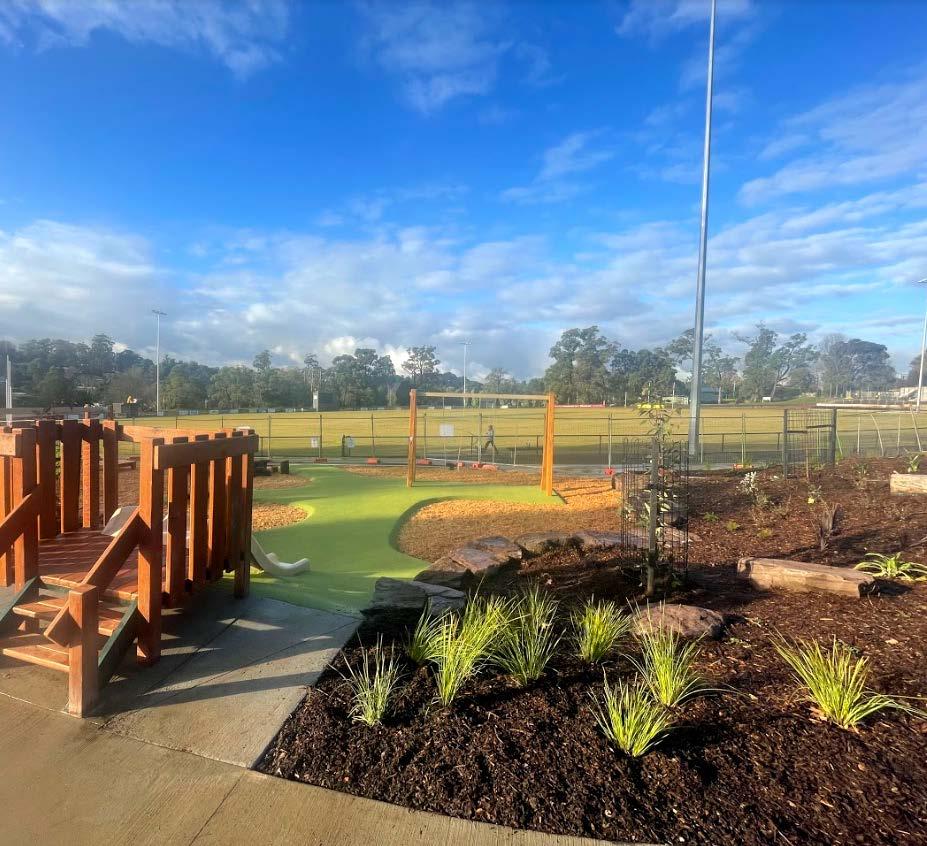
The Monbulk stormwater harvesting scheme was completed as part of a collaborative project to protect local creeks and save drinking water. The system captures and treats stormwater from a 17 ha catchment and uses it to irrigate Monbulk Recreation Reserve.
UNDERGROUND STORAGE TANK
The water is diverted from a roadside council drain next to Monbulk Recreation Reserve to a 310 kL water tank that collects stormwater underneath the reserve. The underground storage tank has two access points to allow tank inspection and maintenance. Regular cleaning of the tank interior is required, involving the use of a hydro-vacuum truck and confined space equipment.
WATER TREATMENT
Before being released for use, water quality is automatically tested using monitoring probes for pH and EC analysis. If the water quality falls within specified ranges, it proceeds through a screen filter for secondary treatment. The filtered water then flows into the UV unit for disinfection and then directed to the irrigation system. In addition, treated water is tested for E. coli at least quarterly, as recommended by the Australian Guidelines for Water Recycling - Stormwater Harvesting and Reuse, 2009.
WHAT HAPPENS IN DRY YEARS?
The system always has mains-water back up available.
Yarra Ranges Council’s Acting Director of Planning and Sustainable Futures, Hjalmar Philippsa, said that in average rainfall years, the system is expected to supply treated stormwater with around 80 per cent reliability, meaning some mains water will still be required.
Hjalmar said, “In wetter years, a greater proportion of water demand can be supplied with stormwater. However, even in dry years, the calculated reliability to supply stormwater is still around 70 per cent.
“The system has been designed to capture runoff from the irrigation under drains and redirect this to the storage tank. This allows a portion of the mains water to be re-used, even in dry years.”
LESSONS LEARNT
Every project has its unique challenges that need some creative problem solving. At Monbulk Recreation Reserve, the major challenge was space constraints.
14
ALTERNATIVE WATER SOURCES
The project will reduce the council’s reliance on mains water for irrigation and will help to protect nearby waterways.
Hjalmar said, “Space constraints meant that an underground tank installed beneath an access road was the least intrusive option. However, this was more expensive than an equivalent size above-ground tank.
“As a precaution, bollards were installed above the underground tank to prevent heavy vehicles parking on top for extended periods. These bollards are lockable and can be removed to allow greater access for car parking on match days.”
OUTCOMES
The harvesting pumps were commissioned on 20 September 2023 and the system is now operational.
Using treated stormwater to irrigate this sports field will save about 4 ML of mains water each year. It will also benefit the environment by reducing the amount and velocity of stormwater, which can carry pollutants and bacteria, from entering the local creeks, the Yarra River, and Port Phillip Bay. In addition, it will protect water quality in nearby Emerald Creek, supporting the breeding platypus population.
“This is a great step forward for the Monbulk community, making use of alternative water sources – like recycled water and stormwater – reduces pressure on our drinking water supplies while improving the liveability of our communities,” said Micah Pendergast, Melbourne Water Incentives Coordinator for Waterways & Catchment Services North West.
The project is a priority project for the Yarra Integrated Water Management (IWM) Forum, which is one of the five IWM Forums in Metropolitan Melbourne established through the Victorian Government’s IWM Program. The Victorian Government provided funding for the project through the IWM Program. The project was also funded by Melbourne Water and Council.
How stormwater harvesting works
Stormwater harvesting involves collecting, treating, storing and using stormwater runoff from urban areas. It differs from rainwater harvesting as it includes the water runoff from roads, carparks and driveways, rather than just the cleaner rainwater runoff from roofs.
Using harvested stormwater for irrigation can help reduce:
• pollution in waterways
• stream erosion
• reliance on mains water
• local flooding events

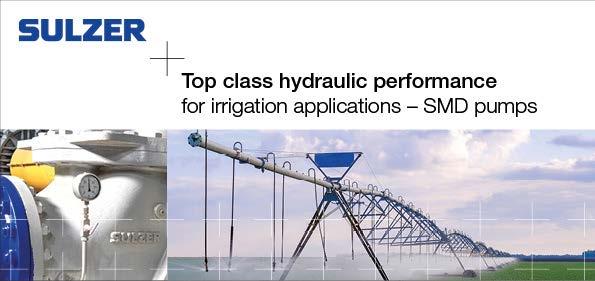 Graphic supplied by Melbourne Water
Graphic supplied by Melbourne Water
ALTERNATIVE WATER SOURCES
Three questions to ask when designing a rainwater harvesting system
SNAPSHOT
• Rainwater harvesting is a simple concept, but there are a few key questions you need to ask right at the start, before getting to the nitty gritty of system design.
• What are the rainwater needs? Determine the quantity and quality of rainwater required based on local rainfall patterns and intended usage.
• What storage vessel is best? Choose the appropriate tank type, size, and material, considering property constraints and storage capacity.
• What are the characteristics of the collection area? Assess the roof, gutters, and surrounding environment for pollutants and potential issues that could affect water quality.
• This article by Rain Harvesting outlines what you need to know to get started.
A common misconception about collecting rainwater is that all you need is a tank, gutters, downpipes, and some rain. However, it takes more than this to design a good rainwater harvesting system.
Queensland-based company Rain Harvesting has developed an online course called ‘12 steps of rain harvesting’. The first three of the 12 steps are described in this article.
1. WHAT ARE THE RAINWATER NEEDS?
When it comes to rain harvesting, we use two operative words when determining measurable goals – quantity and quality.
How the client will use the rainwater and how much they need are the cornerstones in your decision-making when building an effective rainwater harvesting system.

Rainwater harvesting is a simple concept but to design a great rainwater harvesting system there are a few key questions you need to ask right at the start.
16
How much can be collected? It is imperative to understand the rainfall of the local area and how much it fluctuates throughout the year. Average rainfall data is available through your local council or the Bureau of Meteorology.
Once you understand the rainfall patterns, you need to establish how much water can actually be collected. This depends on the roof size and how the water is being directed to the tank. As a rule of thumb, for every 1 mm of rainfall, you will collect 1 L of water per square metre of the collection area. For example, if it rained 100 mm in a month, you could potentially capture 13,000 L from a 130 m² roof.
Next, you’ll need to assess if this is enough for the client’s needs based on their water usage. If not, then you’ll need to increase the collection area to make up for the shortfall. If you’re unsure, a mass balance tool can help your calculation.
Your ability to capture water is also contingent on the property’s capacity to store the water, which we’ll address in Step 2.
As a rule of thumb, for every 1 mm of rainfall, you will collect 1 L of water per square metre of the collection area. For example, if it rained 100 mm in a month, you could potentially capture 13,000 L from a 130 m² roof.
What quality of water do you need? If you’re using rainwater for irrigation and other outdoor purposes, you’ll only need to do a minimum amount of work to bring it up to a moderate level. Minimal filtration is required to keep out larger debris to ensure pumps are protected and irrigation equipment can function smoothly without the risk of blockages. For use with internal appliances, such as washing machines, and toilets, you will need to attain a higher level of water quality to minimise water colour and odour.
If you’re planning on using rainwater for all purposes, especially drinking, the system will need to be designed to achieve the highest quality and best-tasting water by eliminating any remaining sediment before use.
2. WHAT STORAGE VESSEL IS BEST?
Once you’ve established the quantity and quality of rainwater required, you need to determine the right storage vessel. Storage capacity is just as important as a property’s ability to capture water, this is where you need to look at the makeup of the property and the storage vessels themselves. In some situations – for example, if only a small amount of water is needed – then a rain barrel or smaller tank will get the job done.
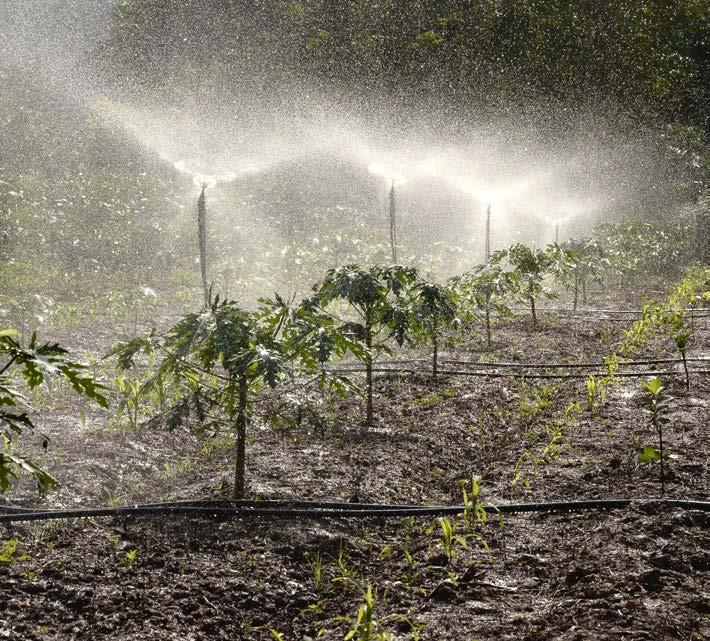
What quality of water is needed? If you’re using rainwater for irrigation and other outdoor purposes, you’ll only need to do a minimum amount of work to bring it up to a moderate level.
However, if more water is required, there are various options available.
Choosing the best storage vessel. An above-ground tank or an in-ground tank might be the best option, depending on the property’s aesthetics and the available space.
First, consider the position of the tank. It could be standalone next to the building, under a deck, or down the side of the house. From here, you can select between above-ground or in-ground tanks, which opens up the options for locations.
In-ground tanks can help to save space at ground level, and because they tend to sit much lower than the house, it can make it much easier to have a good amount of fall from the gutter to the tank inlet. This might allow for a much larger volume tank, where an above ground tank might be limited by the height of the house.
The next step is to consider the type of material the tank is made of. This typically comes down to aesthetics, and what is available through local tank manufacturers. The most popular materials are concrete, steel, and plastic, all of which provide a strong, durable vessel.
When it comes to shape, it’s important to consider space. If the property has limited space, and tight specifications, then the best option might be a slimline tank that hugs the side of the house. However, if the property has more space and flexibility, a good option might be a classic round tank with greater storage capacity.
Depending on the size and shape of the available space, it might also be possible to connect multiple smaller tanks to increase the volume if requirements change.
WINTER 2024 17
ALTERNATIVE WATER SOURCES
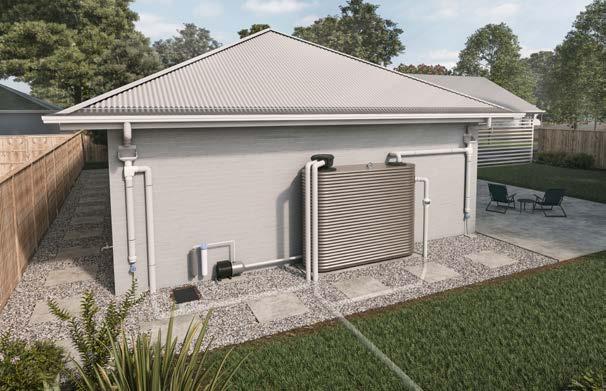
The choice of tank will often come down to aesthetics and space.
Consider the whole system. Two main systems exist to connect the roof and downpipes to the tank: dry and wet systems.
A dry system enables water to flow directly from the roof to the tank. There are no upward sections in the pipe. This means water is never stored in the pipes, as they completely drain every time there is rainfall.
Dry systems are often simpler to install with existing buildings and can be achieved by re-routing a few pipes, with minimal plumbing or groundwork required. However, depending on the roof style (e.g., gabled), it might be difficult to connect a large area of the roof to the tank.
In this case, if you need to increase your collection area, you might need to consider a wet system to enable more water capture.
Wet systems (or charged systems) enable you to connect much more of the building to the tank, maximising water capture.
This is achieved by connecting pipes that come from the building, into the ground, and then back up to the tank. These are often easier to set up on a new site, as the pipes need to be routed underground to get back into the tank.
3. WHAT ARE THE CHARACTERISTICS OF THE COLLECTION AREA?
When assessing the rainwater collection points, there are three main areas to consider – the roof, the gutter, and the surrounding environment.
Roof. The roof plays an integral role in the rainwater system, as it is the first zone that the water encounters. You need to assess the risk for a variety of pollutants that can wash into the system.
The main factors you need to look out for are:
• lead paint and flashings
• flaking or corroded material
• cracked tiles.
If any of these are found during your initial inspection, it is recommended you replace or fix them before progressing with any collection.

Gutters. The next area to assess is the gutter. As with the roof, you need to be on the lookout for any flaking material or signs of corrosion that can lead to contaminants entering the system.
Furthermore, you need to ensure there are no opportunities for water to pool, which can cause corrosion and provide an environment for mosquitoes to breed.
The primary cause of water pooling is a damaged gutter or one where the fall is not adequate to allow for sufficient water flow to the downpipe. Spray water into the gutter with a hose to assess the situation and adjust or replace gutters where required.
Environment. Once the roof and gutter are assessed and cleared, it’s important to look at the surrounding environmental factors that can affect rainwater quality and the strategy for the system.
Inspect the roof for moss or heavy organic build up. If found, it is recommended to get the roof professionally cleaned.
If overhanging trees are present, they should be trimmed back to prevent leaf litter from landing on the roof. Alternatively, install gutter mesh to reduce leaf load as much as possible, while also preventing any wind-blown leaves from surrounding properties or trees from depositing and breaking down in the gutters. Reducing the volume of leaves at the roof plays a huge part in reducing the debris load throughout the entire system, which means better water and less maintenance of the system.
Gutter mesh is also instrumental in preventing pests and embers from entering the gutter system and roof cavity, and further protects the property.
Once the collection area is deemed suitable to capture rainwater, you can move forward with designing the system.
Acknowledgment. This article is an extract from Rain Harvesting’s ‘12 steps of rainwater harvesting’ article, which is available here
Information. For more information, visit the Rain Harvesting website. You can find the rain harvesting online course here
18
LEFT: residential slimline tank.
RIGHT: round poly tank.

DESALINATION FOR AGRICULTURE –BENEFITS AND CHALLENGES
Desalination is a process that removes dissolved salts from seawater, municipal or industrial wastewater and brackish or saline inland water. The process results in two streams: permeate (purified water), and brine (concentrated salts), which requires disposal.
BENEFITS
• Water security: Desalination provides a reliable water source, enhancing agricultural resilience to drought and climate variability.
• Water quality improvement: Reducing water salinity through desalination boosts crop productivity. For instance, a 25 per cent reduction in water salinity can double grape vine productivity.
• Water conditioning: Desalinated water can be enhanced with fertilisers and minerals (fertigation), tailored to specific crop needs.
• Efficiency: Desalination supports the use of water-saving irrigation techniques, particularly for high-value crops.
• Productivity increase: Treated desalinated water can significantly improve agricultural productivity, potentially offsetting its higher costs.
CHALLENGES
• Seasonal demand: Variable water demands can make desalination costly if used sporadically. Consistent operation at full capacity is most cost-effective, which can be managed with water storage solutions, such as managed aquifer recharge.
• High costs: Desalinated water typically costs more than other water sources, influenced by factors like feedwater quality and brine disposal.
• Perception and expertise: High costs, limited expertise, and low confidence in implementation hinder the broader use of desalinated water in agriculture.
• Operational costs: Brackish water desalination incurs significant operational costs, with energy comprising up to 50% of these costs. Renewable energy sources can reduce these expenses but are currently used only in small-scale operations.
• Additional expenses: Costs also depend on infrastructure needs, such as pipelines, borefields, and storage facilities for treated water.
• Brine disposal: If not very carefully managed, brine disposal can harm the environment.
Sources Review of low-cost desalination opportunities for agriculture in Australia, CSIRO. and ‘More desalination is coming to Australia’s driest states – but super-salty outflows could trash ecosystems and fisheries’ on The Conversation.
THE BIG ISSUE
PEAK WATER: DO WE HAVE ENOUGH GROUNDWATER TO MEET FUTURE NEED?
SNAPSHOT
• A new study shows that by mid-century, nearly half the global population could face higher food prices and altered trade due to costly groundwater.
• Nine percent of the world's water basins are nearly depleted, with an additional 11.5 per cent expected by 2030 and 22 per cent by mid-century.
• Researchers from the Pacific Northwest National Laboratory in the USA studied 235 water basins, using 900 scenarios to predict when and where groundwater withdrawals might peak.
• Key regions like the Western United States, Mexico, India, Pakistan, China, and several Middle Eastern and Mediterranean countries are likely to face early groundwater peaks.
• These areas, crucial for global food production, are responsible for most unsustainable groundwater withdrawals and may need to shift away from groundwater reliance.
• Regions with plentiful surface water or low water demand, such as the Amazon and higher-latitude areas like Canada, are less likely to experience groundwater depletion.
Though vast stores of groundwater persist below Earth’s surface, the climbing cost of accessing it is on track to significantly reshape the geography of trade and drive users toward alternative water sources.
A new study has found that by mid-century nearly half the global population could live in areas where groundwater will become so costly as to raise regional food prices and significantly alter the geography of trade and crop production. Nine per cent of the world’s water basins appear to have already reached such a state of near depletion. The new research, led by scientists at the Department of Energy’s Pacific Northwest National Laboratory, suggests an additional 11.5 per cent could reach this point by 2030, with another 22 per cent joining by mid-century.
The authors of the new work sought to identify when and where water withdrawals from many of the world’s aquifers could ‘peak’, as in, when external forces could drive groundwater extraction to reach its maximum. Similar peaks have been observed in other resources, like fossil fuels or minerals.
But, until now, no study has observed and quantified the same behaviour in groundwater. This new work marks the first time anyone has projected the peak and decline of

By mid-century, nearly half the global population could live in areas where groundwater will become so costly as to raise regional food prices and significantly alter the geography of trade and crop production.
20
Photo: Valio84sl / Shutterstock.
water withdrawals in relation to demand from human-driven systems. It represents “the most extensive, large ensemble experiment focused on future global groundwater extraction to date,” said lead author and Earth scientist Hassan Niazi.
Though water is conserved within Earth’s hydrosphere and never truly ‘lost’, the new work affirms that groundwater does behave as a non-renewable resource, constrained in part by the cost of retrieval. Those who study groundwater recognise this, said coauthor and Earth scientist Tom Wild.
“While it’s not new for us to show that groundwater behaves like a non-renewable resource,” said Wild, “our work provides a very stark and visible reminder of groundwater’s finite nature, given how similar our projected groundwater patterns are to other resources that are in the process of being exhausted.”
Yet the rate at which groundwater is extracted globally, said Niazi, runs counter to this idea. Withdrawal rates, after all, continue to rise.
“About a fifth of the world’s food is grown using groundwater,” said Niazi. “So, it’s important to recognise that groundwater, particularly that in deep aquifers, is finite, much like oil or copper. And understanding when this depletable resource will peak and decline can help us carve out an informed path forward, as many regions face the imminent challenge of reducing their groundwater reliance. That’s important because groundwater is tied to so many essential functions of society, from irrigation to energy and, inseparably, to the well-being of our environment.”
The new work was published recently in the journal Nature Sustainability.
What drives a peak?
Though vast stores of water persist beneath Earth’s surface, the cost of extracting it climbs as water tables fall lower. More energy must be spent to overcome gravity when pumping groundwater to the surface.
When an aquifer’s level falls so low that its water can no longer be reached or the toll of doing so grows too costly, groundwater extraction reaches a point of either physical or economic infeasibility. Past this point, groundwater withdrawals typically decline as people look toward alternatives.
Other forces, too, can influence when such a peak may come. New technology like more efficient irrigation systems could dial down the amount of water people need in a region, offsetting a potential peak. Or groundwater-reliant populations could grow smaller, meaning there’s less demand. A complex system of factors stands to affect when basins peak and decline.
And that is exactly the complexity the researchers behind this new work sought to capture. Much of the research on groundwater depletion investigates when and where aquifers may physically ‘run dry’. Yet this is only one part of a complicated picture.
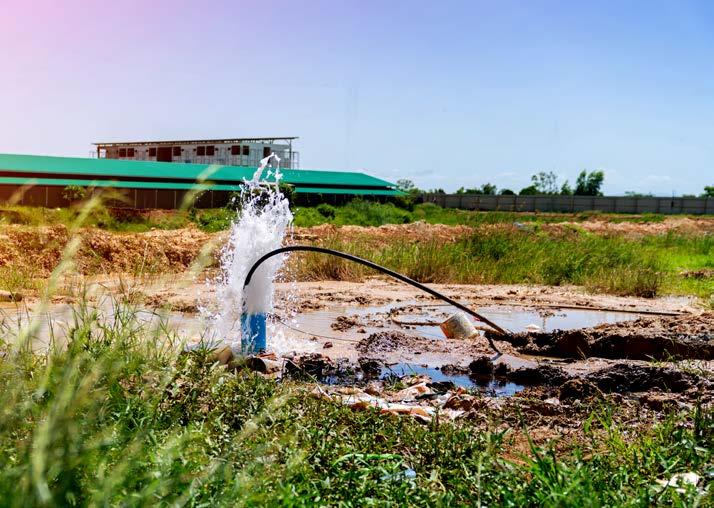
Though vast stores of water persist beneath Earth’s surface, the cost of extracting it climbs as water tables fall lower. More energy must be spent to overcome gravity when pumping groundwater to the surface.
Peak water: when and where
Niazi and his coauthors examined 235 water basins across the globe. Complex simulations allowed them to probe the many factors that could drive basins to depletion across a range of hypothetical futures. Population growth, electricity demand and water use efficiency, among other socioeconomic factors, stand to shape when and where basins could peak.
To capture the uncertainty at play, the authors considered 900 total scenarios. They identified hotspots where peaks are most likely to pop up. In nearly all simulations, global groundwater reserves show a distinct peak and decline signature this century.
The timing and location of peaks differ depending on the nature of each scenario. Some basins, however, show a peak and decline signature across almost all scenarios.
Which are on track to peak in the coming decades? Those basins land within the Western United States, Mexico, India, Pakistan, China and several countries in the Middle East and Mediterranean. These are the same regions at the center of the Green Revolution, where crop production swelled in the early 20th century.
These same basins still serve as breadbaskets for most of the world. Yet, at the same time, the authors point out that these regions are responsible for most of the world’s unsustainable groundwater withdrawal. They are positioned to be on the receiving end of groundwater stress, should current withdrawal trends continue.
“At the very least, key basins in many of the nations responsible for the past 50 years of global agro-economic productivity could be forced into a transition away from groundwater use,” said Wild. “Our findings highlight imminent transformations in the way these regions conduct trade and manage water.”
WINTER 2024 21
Photo: zblaster / Deposit Photos.
THE BIG ISSUE

non-renewable
Roughly half the basins under study do not peak and decline in any scenario. These include regions like the Amazon, where inexpensive surface water is sufficiently plentiful to meet projected demand, or areas where water needs are anticipated to be quite low, like in the higher latitude areas of Canada. Twenty-one basins have already peaked or are in the midst of peaking, including those in California and Missouri.
Peak and decline: what follows
What happens when a region peaks? With water supplies becoming increasingly limited, climbing water costs can cascade across sectors, causing food prices to rise—this could spark shifts in international trade as nations seek to import crops or water from less expensive regions. While not specifically addressed in this study, many prior studies have shown that as groundwater demand increases, aquatic ecosystems could face greater stress, water contamination could spread, and the land above diminished aquifers could
sink into the earth more often—a phenomenon known as land subsidence.
The authors add that competing interests for water stem from many sectors: energy, manufacturing, agriculture, livestock, etc. Each of these can face unforeseen stress due to increasing demand for water within a region, driving a resultant rise in groundwater extraction.
“There’s great value in considering multiple sectors and their interactions in an integrated way,” Niazi added. “These analyses can help us to make more informed decisions when we face challenges not only in the realm of groundwater, but also challenges related to sustainable agriculture systems, or with planning a resilient grid.”
The authors highlight that nations with previously untapped ground or surface water resources could help to meet a gap in demand. Afflicted regions may need to expand rainfed croplands, or import crops through international trade, or seek less water-intensive power plant cooling technology, among other strategies.
22
This figure depicts the percentage of 900 simulated scenarios in which the annual rate of
groundwater withdrawal peaks and declines over the 21st century. Many of the basins that have been responsible for the past five decades of global agroeconomic productivity show peak and decline signatures across the lion's share of scenarios. (Figure by Hassan Niazi | Pacific Northwest National Laboratory)
Niazi and his coauthors point out some limitations of their work. More thorough records of groundwater withdrawals would strengthen future analyses. Considering other forms of adaptation, too, could better capture future paths on offer.
“Water is, of course, among the most important resources we manage,” said Wild. “Understanding our future with groundwater – all water, really – requires that we must understand it holistically. That means understanding how water withdrawal interacts with energy demand, with food production, with the extraction of raw materials, and more. And that’s what we’ve set out to show in this work.”
This work stems from the Joint Global Change Research Institute, a partnership between the University of Maryland and PNNL. There, researchers from a wide range of disciplines collaborate to model human and Earth systems, from those that harness and deliver energy into our homes to those that govern extreme weather. Their research helps provide decision-relevant information for management of emerging global risks and opportunities.
In addition to Niazi and Wild, authors of this work include Neal Graham, Son Kim, Mengqi Zhao, Sean Turner, Mohamad Hejazi, Siwa Msangi, and Jonathan Lamontagne. This work was supported by DOE's Office of Science.
Acknowlegment. Reprinted with permission from Pacific Northwest National Laboratory, USA. The original article can be found here.
Groundwater in Australia
• Australia’s groundwater use has increased significantly over recent decades. For example, in 13 years from 1983 to 1996 groundwater use increased by nearly 90 per cent. It is projected to continue rising.
• Irrigation accounts for just over half of Australia’s groundwater use.
• The Great Artesian Basin is Australia’s largest groundwater basin and one of the largest freshwater resources in the world. It covers 22 per cent of the continent and stores an estimated 64 900 million ML of water – enough to fill Sydney Harbour 130, 000 times.
• Groundwater makes up about 17 per cent of Australia’s accessible water resources and may account for up to 30 per cent of total water consumption in particular regions.
• Western Australia, New South Wales and Queensland are the highest groundwater users of the Australian states and territories.
• The Northern Territory has the greatest reliance on groundwater, sourcing 90 per cent of its water from aquifers.
Sources. Australian Government Geoscience Australia website Groundwater Essentials (2012), Australian Government. Harrington N and Cook P, 2014, Groundwater in Australia, National Centre for Groundwater Research and Training, Australia.
IRRIGATION AUDITING CATCH CANS
AVAILABLE FROM IRRIGATION AUSTRALIA
Measure the application rate and uniformity of all types of pressurised irrigation –from handheld hoses to a centre pivot.
Order your set now from Irrigation Australia.

Catch cans with plastic spikes
Set of 12
AU $55.00 (incl GST)
Members: AU $47.00 (incl GST) Plus postage
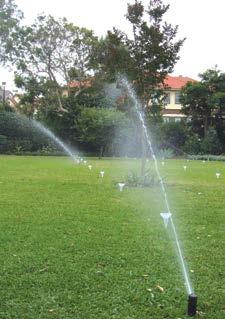
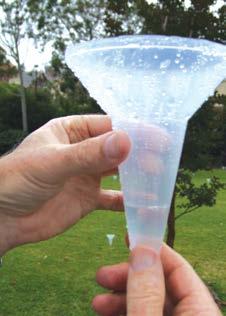
Catch cans with metal spikes
Set of 10
AU $95.00 (incl GST)
Members: AU $85.00 (incl GST) Plus postage
Brendan Bane, Pacific Northwest National Laboratory.
Order online at www.irrigationaustralia.com.au (go to the Store tab and then select “Merchandise”) or contact Irrigation Australia, phone 07 3517 4000.
Map out your own career path –certifications and short courses to suit everyone
Irrigation Australia offers many training courses and certifications. Whether you are just dipping your toes in the water or have been around for years and want to expand your skillset, we have a course to suit you.
One of the great things about our training and certification options is their flexibility. We can help tailor a program for you, and you don’t necessarily need to make a huge time commitment or financial investment.
Courses and certifications range from single day courses – such as Certified Electrofusion Welding – through to two years for the diploma-level Certified Irrigation Designer.

FLEXIBLE LEARNING
The Knowledge Pathway below shows a typical path you might take if you are new to the industry – perhaps straight out of school or moving from another industry. The Irrigation Efficiency three-day course is a good starting point. From there, you can continue on the path as shown, or mix and match courses in a way that suits your experience level, interest and relevance to your career.
If you choose to continue studying, the units that make up each of these short courses can contribute to a Certificate III in Irrigation, our most popular certification.
In reality, everyone’s path looks different, and the staff at Irrigation Australia can help map your path out.
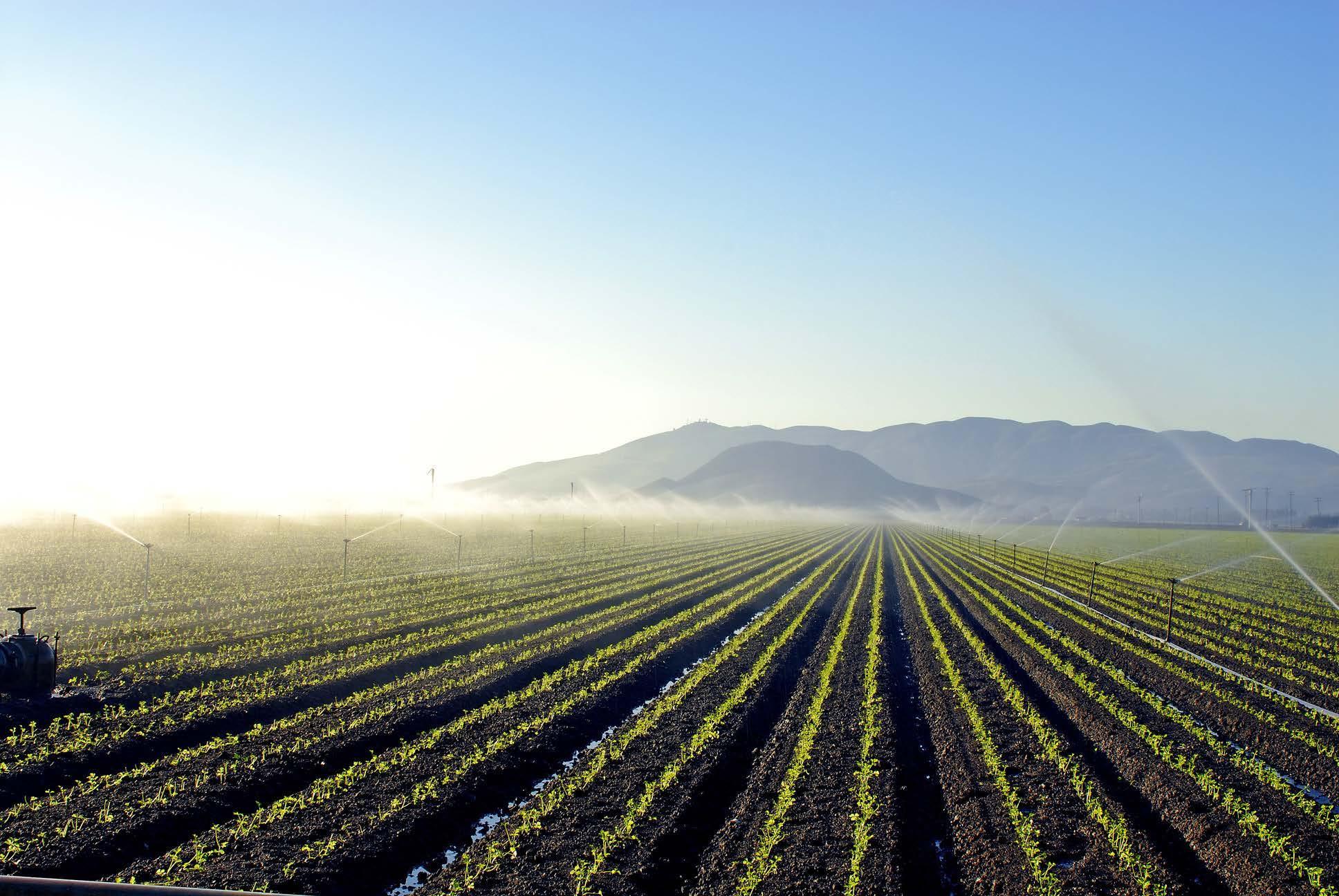
24
DEVELOPMENT
PROFESSIONAL
5 Day Delivery - Diploma Level Content Irrigation Efficiency 3 Day Delivery - Certificate III in Irrigation Technology Accredited Units Irrigation Pumps & Systems Certified Irrigation Installer Certified Electrofusion Welder Certified Butt Welder Pivots & Lateral Moves Certificate III in Irrigation Technology AHC32422* Certified Irrigation Contractor Advanced Design Concepts Certificate IV in Irrigation Management AHC41119 Certified Irrigation System Auditor Certified Irrigation Designer Knowledge Pathway 2024 - 2025 Certified Irrigation Operator Certified Meter Installer & Validator Certified Storage Meter Installer & Validator 3 Day Delivery - Certificate III in Irrigation Technology Accredited Units 5 Day Delivery - Certificate III in Irrigation Technology Accredited Units 5 Day Delivery - Certificate III in Irrigation Technology Accredited Units 1 Day Delivery - Certificate III in Irrigation Technology Accredited Units 1 Day Delivery - Certificate III in Irrigation Technology Accredited Units 3 Day Delivery - Certificate III in Irrigation Technology Accredited Units 3 Day Delivery - Certificate III in Irrigation Technology Accredited Units 3 Day Delivery - Certificate III in Irrigation Technology Accredited Units 18 Day Delivery over 12 Months 12 Day Delivery over 12 Months 5 Day Delivery - Certificate IV in Irrigation Management Accredited Units 3 Day Delivery - Certificate IV in Irrigation Management Level Content Own pace over 24 MonthsDiploma Level Content RTO 91313 *Government funding may be available for eligible students Contact Irrigation Australia for details (07) 3517 4000 training@irrigation org au
WHAT IS CERTIFICATION?
Certification is a national program of industry recognition. Certification is a licence earned by a person to certify that he or she is qualified to perform a job. Certification indicates that the individual has a minimum set of knowledge, skills, or abilities in the view of the certifying body to perform their job to the satisfaction of water managers and customers.
Why become certified?
Certification grants you a point of difference in the marketplace. Irrigation Australia’s certification program is highly regarded by customers to provide a service that meets or exceeds the average industry standards. It is increasingly valued by employers, and many state and local governments now require that irrigation jobs are designed and completed by certified professionals.
Training coordinator Sam O’Brien explains, “Where you start and what courses you complete depend on your experience, your role and your interests. If you’ve been in the industry for a while, you can start wherever you want in this knowledge pathway. There are no prerequisites for any courses we offer.”
RECOGNITION OF PRIOR LEARNING
There is also the option of recognition of prior learning (RPL). If you can demonstrate competency in a certain area, you can apply for credit, meaning your existing knowledge contributes to your certification.
HOW TO GET STARTED
Our friendly training team can help plan the best training approach for you. Contact us on info@irrigation.org.au or 07 3517 4000.
Or visit the Irrigation Australia website here to find out more about our training and certification options.
FIRST CHOICE FOR QUALITY HOSE, VALVES, AND FITTINGS FOR THE IRRIGATION INDUSTRY
You can count on our expert and committed team specialising in irrigation. We have the ability to source unique and specific industry products.

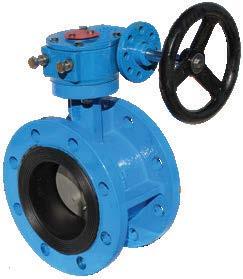
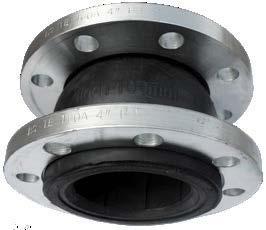
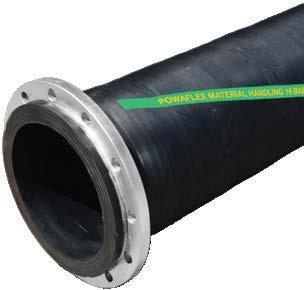
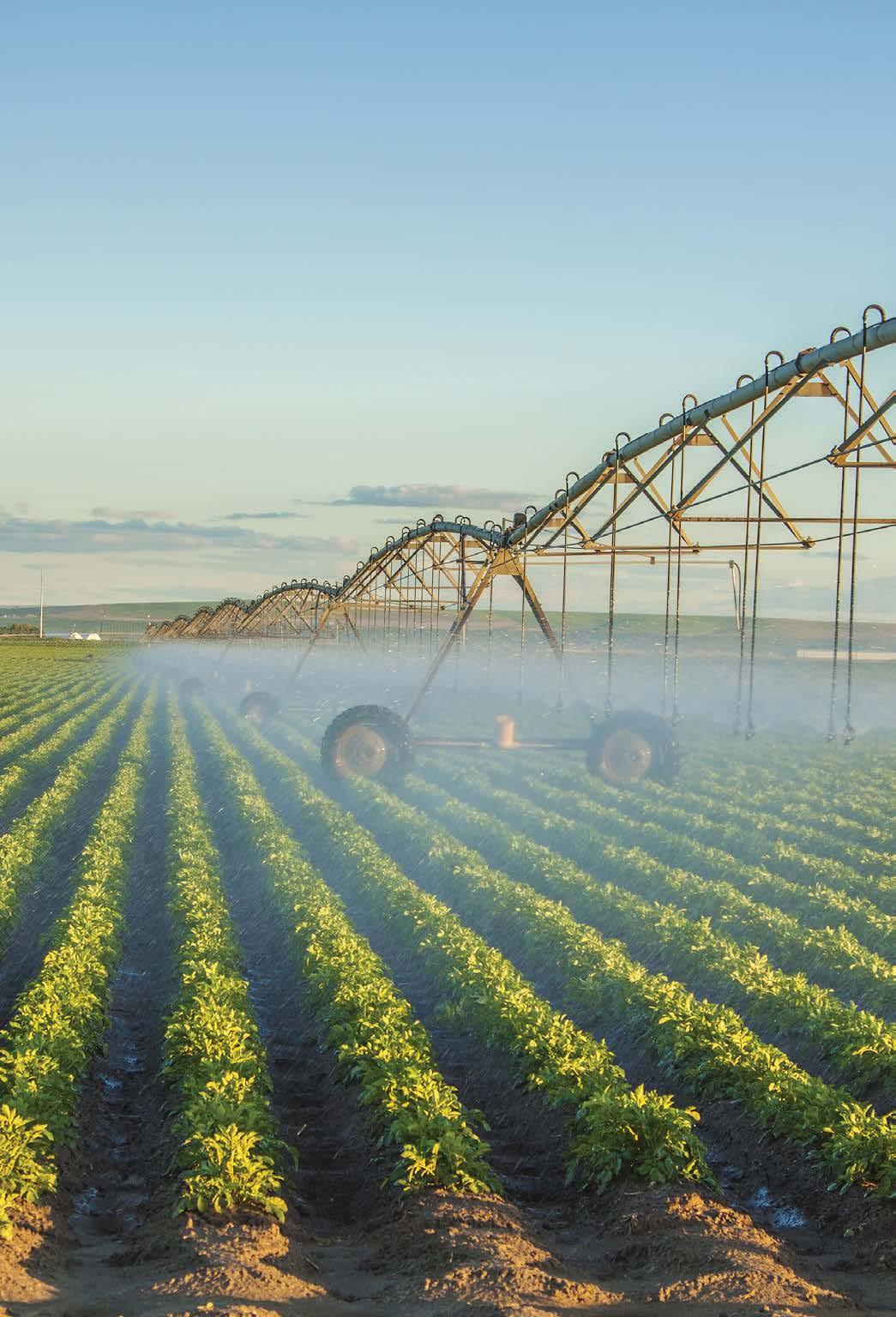
advancedindustrial.com.au
PROFESSIONAL DEVELOPMENT
Meet the trainer: Luke Cummins
“Expect not to spend much time in your chair,” is how Luke Cummins sums up the training courses he runs with Irrigation Australia. If you’ve ever completed one of our training courses, you’ll know that we have some passionate trainers on the job and Luke is no exception.
This article is the first in a series where we introduce some of our expert trainers. Here we chat with Luke who’s been running courses in electrofusion and butt welding with Irrigation Australia for the last five years.
Like many in the irrigation industry, Luke has a varied background that has given him a wide range of skills. When Luke left school, he wasn’t sure what he wanted to do, so he set out to get a taste of everything.
“I focused on gaining as many skills and qualifications as I possibly could,” Luke said.
He worked in the military, resources, manufacturing, engineering, civil infrastructure, aviation, sales and HR consulting. During this time, Luke discovered that training came naturally to him.
“I soon realised I could create faster and more effective ways of learning and growing. I ended up in oil and gas as a trainer assessor on a $60 billion project and was responsible for onboarding 22,000 personnel, identifying and meeting their training needs,” Luke said.
TEACHING TO FIT THE LEARNER
Luke now combines his considerable inter-personal skills and expertise in training with his knowledge of electrofusion and butt welding to run courses with Irrigation Australia. Underpinning everything he does is an understanding of human psychology.
The training content itself is important, but Luke emphasises that there are other equally critical components of a good training course. He’s a firm believer in the value of practical experience and connecting with people.
“When it comes to people, if you have walked in their shoes, you can connect with them and accelerate their learning. The learner must be at the centre of all learning strategies and techniques. Reverse-engineer the learning information from there, so it fits the learner’s ability.
“The more boots-on-the-ground experience and applied knowledge a trainer has, the more they can influence growth in people,” Luke said.
Luke says he say his proudest moments as a trainer are those where he has guided trainees with no knowledge or practical experience to become highly competent operators.
“I love showing people what is possible and watching them enjoy themselves in the process,” Luke said.
“The learner must be at the centre of all learning strategies and techniques. Reverse-engineer the learning information from there, so it fits the learner’s ability”.

MAKING LEARNING RELEVANT AND ENJOYABLE
Making learning enjoyable and relevant is at the heart of Luke’s approach.
“When you think of the best learning experiences you've had, it had a profound impact on you. You remember the feeling you had and the way it influenced your life. That's because it was relevant, made sense, was high impact and fun”.
When Luke isn’t training irrigation professionals, he channels his immense energy and understanding of human psychology into his own consulting company, Rogue Institute, helping business owners develop practical strategies to grow their business, improve workplace relationships, resolve conflicts, foster more productive employees and more.
26
Luke Cummins (middle with white cap) focuses on making classes relevant, high impact and fun.


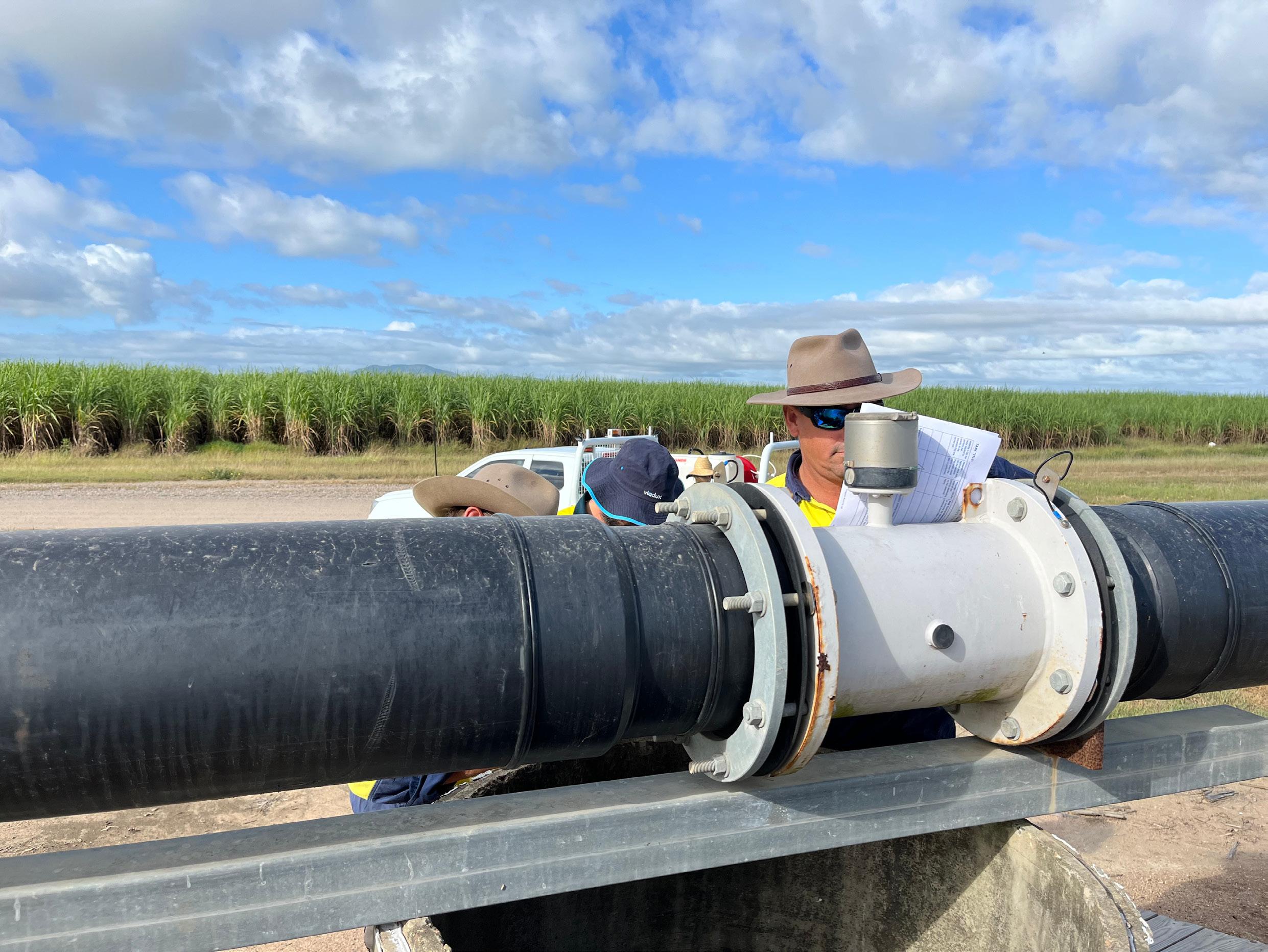

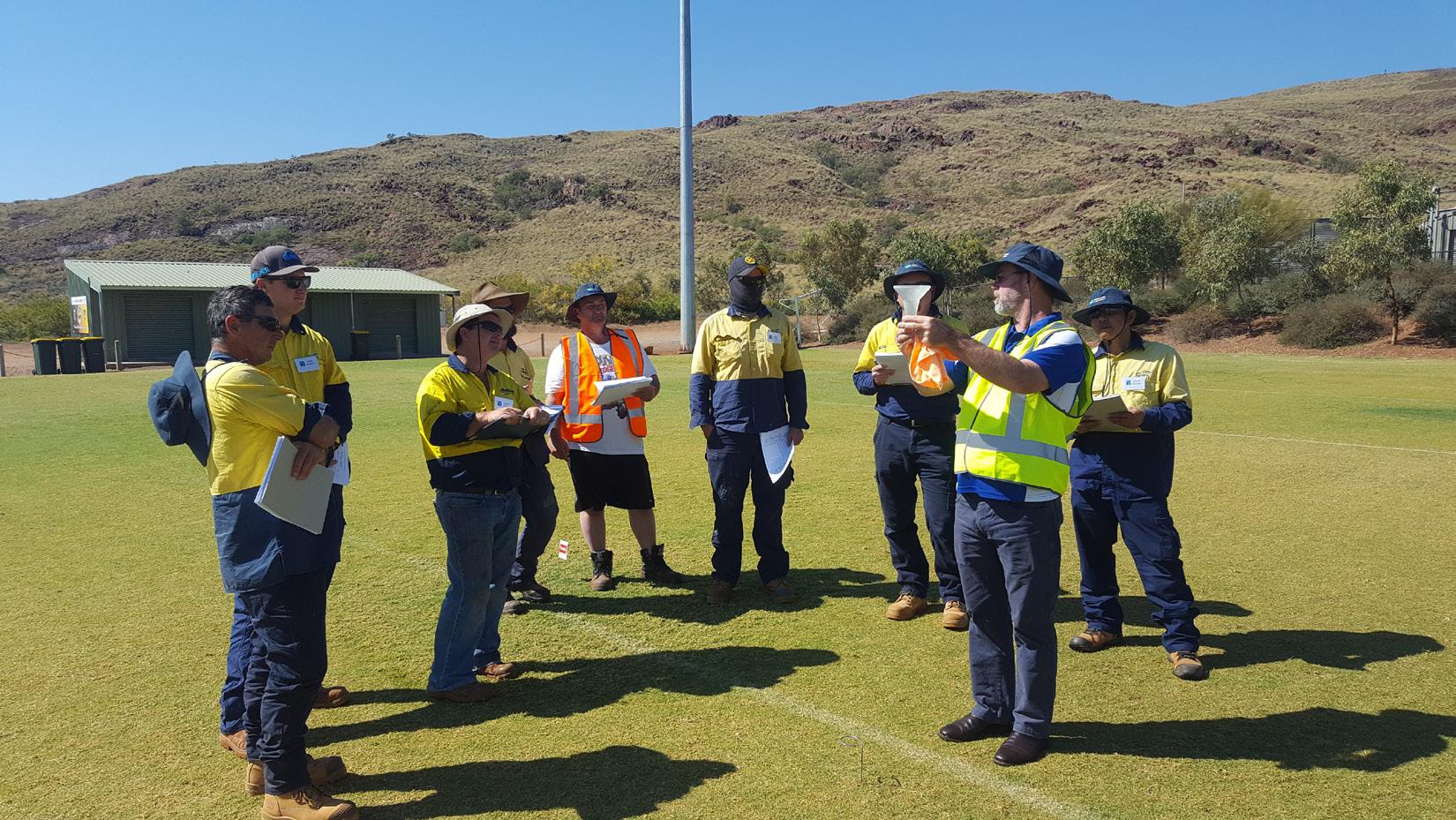







(07) 3517 4000 www.irrigationaustralia.com.au training@irrigation.org.au I N D U S T R Y E X P E R T T R A I N E R S P R A C T I C A L A P P R O A C H B L E N D E D L E A R N I N G Q u a l i f i c a t i o n s N o n - A c c r e d i t e d S h o r t C o u r s e s A c c r e d i t e d S h o r t C o u r s e s D e s i g n C o u r s e s
7 N a t i o n - w i d e T r a i n i n g 1 2 + C a r e e r P a t h w a y s
T R A I N I N G W I T H I R R I G A T I O N A U S T R A L I A
2 2 3
T R A I N I N G P R O G R A M S O N O F F E R B e c o m e a C e r t i f i e d I r r i g a t i o n P r o f e s s i o n a l a n d c h o o s e f r o m o u r S p e c i a l i s t C e r t i f i c a t i o n s ! 1 0
1 6 +

IRRIGATION AUSTRALIA CONFERENCE AND EXHIBITION: A PREVIEW CONFERENCE
We look forward to welcoming you to the Irrigation Australia Conference and Exhibition in Sydney from 2 to 4 September. This big event attracts delegates from all over the world and is being held concurrently with the 9th Asian Regional Conference and 75th IEC Meeting. Read on for an update and a preview of what you can expect.

Where: Sydney International Convention and Exhibition Centre
When: 2 to 4 September 2024
What to expect:
4 An unparalleled chance to exchange knowledge with hundreds of researchers and leaders in the water industry from around the world.
4 The opportunity to see the latest innovations in irrigation technology and services at the exhibition.
4 Inspirational keynote speakers.
4 Plenty of fun social activities and networking events.
4 A memorable event in one of Australia’s most spectacular cities.
Registrations: Registrations will close on the 16 of August 2024, so don’t delay. Find out more and register here
Preliminary conference program now available! We received around 80 abstracts from more than 20 countries. All abstracts have now been reviewed, and offers of presentations have been made.
Conference presentations have been allocated to the three sub-themes identified during the call for abstracts and session times have been reserved in the program accordingly. We want to maximise opportunities for interaction within sessions. To enable this, wherever possible the format will be as follows:
• introduction by session chair
• three or four short presentations
• a chaired panel session.
The program focusses on the three large rooms at the ICC Sydney. There will be two concurrent conference streams, along with a stream devoted to Irrigation Australia workshops.
Poster presentations of shorter duration will be held in a theatrette in the Exhibition Hall, during an extended lunch break.
Introducing keynote speaker Katherine Wynn

We are thrilled to introduce one of our keynote speakers, Katherine Wynn. Katherine is an economist and strategic advisor at CSIRO Futures. She advises clients on the emerging trends and technologies shaping industries while designing responsive strategies for more informed investment decisions.
Katherine has led the delivery of several reports in agriculture and food, including the:
• Growth opportunities for Australian food and agribusiness report
• Australia's National Protein Roadmap
• Reshaping Australian Food Systems Roadmap
• Ag2050 Scenarios Report
Prior to joining CSIRO, Katherine worked at Deloitte Access Economics. She holds a PhD in Economics which she completed with Agriculture Victoria and the University of Melbourne with a research focus on R&D investment in the field of agricultural biotechnology. Katherine also holds a Bachelor of Economics, Bachelor of Laws, and Diploma of Language (French) from Monash University.
28
Photo by TKKurikawa / Deposit
Photos
PRESENTATIONS: WHAT YOU CAN EXPECT
Theme 1. Governance – identifying and addressing structural and policy impediments to the adoption of better irrigation practices
Presentation examples Climate-driven strategic infrastructure and modernisation case studies from China, Nepal, Chinese Taipei; Irrigation policy case studies, including water allocation from Australia, Nepal, Pakistan.
Other workshops and activities
Many other workshops and activities will take place in smaller rooms at the venue. Some of these include:
• Rainwater Harvesting Australia workshop
• Smart Approved Watermark workshop
• Member Q&A with the Irrigation Australia Board
2. Investment – fit-for-purpose and cost-effective technologies that support end users to implement sustainable irrigation practices (Environmental, Social, Governance)
Technical presentations on innovative planning, including flood management, innovation and water efficiency in irrigation equipment, modelling, monitoring and other tools from Australia, Chinese Taipei, Nepal, South Korea, Iran.
• Mental health session with TIACS (This Is A Conversation Starter – our charity for the event)
• and more to be confirmed!
You can also look forward to a range of networking and social events, including the Women in Water Breakfast, which will be held on Tuesday 3 September. This was a hugely popular event with inspiring speakers at our last conference in 2022.
Technical tours
Technical tours are being finalised at a small additional cost for conference delegates.
We anticipate there will be three themed day-long bus tours:
• Open space irrigation projects around Sydney including new and brownfield developments, in conjunction with Sydney Water.
• Agriculture and horticulture irrigation case studies around and to the South of Sydney (Shoalhaven region).
• Viticulture case studies to the North of Sydney (Hunter region).
Exhibition
Our last conference in 2022 had more than 800 visitors, 105 exhibitors and 25 partners.
The exhibition will be open to trade visitors, conference delegates and the public to view the latest products, services, and technology the industry has to offer.
The exhibition will be an integral part of the activities and provides an unparalleled opportunity for organisations to come face-to-face with attendees. It is a unique marketplace to increase your visibility, and to showcase and demonstrate your products and services.
Meal breaks are held in the exhibition hall. This year we’ve made a few changes, including longer lunch breaks and interactive activities, to maximise interaction between conference delegates and exhibitors.
3. Capacity development –ensuring that end users can access and adapt knowledge and systems to support sustainable irrigation practices.
Case studies around community and farmer engagement in planning, knowledge exchange, incentive programs from Australia, India, Thailand, Iran.
A focus on mental health: Irrigation Australia partnership with TIACS
Irrigation Australia is pleased to announce that Jason Banks, co-CEO of mental health not-for-profit TIACS, will be speaking at the conference dinner. You’ll also have the chance to attend a mental health workshop with Jason in the interactive zone in the exhibition hall.
TIACS – short for “This Is a Conversation Starter” – is our chair’s charity for at least the next 12 months. You may have seen Irrigation Australia staff wearing Trademutt workwear for a while. TIACS and Trademutt are inextricably linked, with TIACS being the charity arm offering free phone and text counselling, and mental health support for tradies, truckies, rural and bluecollar workers.
Jason Banks tells the story of TIAC in this video.

We still have a few sponsorship opportunities remaining along with booths for the exhibition, should you be interested please get in touch with the events team as soon as possible to ensure you secure your place!
Contact: Robert Gunn 0497 800 962; Abdul Khan 0433 159 345; irrigationpartnerships@theeventgap.com.au
To find out more about the Irrigation Australia Conference and Exhibition and to register, click here

WINTER 2024 29
CONFERENCE
STAYING IN SYDNEY AFTER THE CONFERENCE? HERE
ARE SOME MUST-SEE ATTRACTIONS
Sydney is an iconic Australian destination with world-class event facilities and endless activities to entertain visitors for an extended stay. Here are a few of Sydney’s top visitor attractions.
Sydney Opera House
The Sydney Opera House is more than just an architectural marvel set on beautiful Sydney Harbour; it's also a worldclass working opera house. The iconic sails host more than 1600 performances a year – everything from classical ballet performances, innovative theatre and symphony music to contemporary dance and, of course, stunning opera productions.
The UNESCO World Heritage-listed building offers daily guided tours, available in many languages. Meanwhile, Opera Bar has the best view in town, letting you sip cocktails as you marvel at the Sydney Harbour Bridge. You’ll treasure the same views dining alfresco at the adjacent House Canteen.
Find out more here
Sydney Harbour Bridge
The Sydney Harbour Bridge is one of the world’s most recognisable landmarks. Not only is it the largest steel arch bridge on the planet, but it also spans one of the globe’s finest natural harbours. Affectionately named ‘the coat hanger’ by locals, it’s an intrinsic part of the city; you can walk or cycle across it and even climb to its peak for incredible views.
Find out more here
Art Gallery of NSW
With more than 40 exhibitions annually and vast collections of Australian, Aboriginal and Torres Strait Islander, European and Asian art, there is always something new to discover at the Art Gallery of New South Wales. The gallery is only a 15-minute walk from the city centre and admission is free, as are the daily guided tours. Stop for lunch or a coffee at the on-site restaurant or visit on a Wednesday evening until 10pm for Art After Hours for celebrity talks, music, performances and other special events.
Find out more here

30

Bondi Beach
Sparkling blue ocean, funky eateries and a laid-back beach lifestyle sum up the world-famous Bondi. Go for a swim in an iconic ocean pool at Icebergs, sip a fruity cocktail at a beachside bar like Hotel Ravesis, learn to ride the waves with the experts at Let’s Go Surfing or peruse the Saturday farmer’s markets. Of course, the Bondi to Coogee Coastal Walk is a memorable way to appreciate the beauty of the area. The picturesque 6 km track is carved into sandstone cliffs and offers uninterrupted views of the ocean, passing Tamarama Beach and Bronte Beach, before finishing in beautiful Coogee.
Find out more here
Royal Botanic Gardens
An oasis of 30 ha in the heart of the city, the Royal Botanic Garden occupies one of Sydney’s most spectacular positions: wrapping around the harbour and sitting adjacent to the Sydney Opera House. With a long history dating back to 1816, it is home to an outstanding collection of plants from Australia and overseas. Enjoy a stroll, pack a picnic lunch or join a free guided tour (the Aboriginal Heritage Tour is a highlight).
Find out more here
The Rocks
The Rocks is the birthplace of modern Sydney. With the arrival of European settlers in 1788, it was here that the convicts first set up house and shop. The best way to discover the area’s rich colonial history is on foot as you amble along cobbled streets and follow little laneways that house everything from markets to museums and galleries. Join The Rocks Walking Tours, which start at 6pm outside Cadman’s Cottage, before relaxing in one of the many historic pubs in the area, such as The Fortune of War or The Glenmore.
Find out more here
Chinatown
Sydney isn't the only global city with a Chinatown, but this one is bigger, better and boasts more than most thanks to the Chinese immigrants that started arriving in the 1800s. You can find everything here, from small specialist stores and sprawling Asian grocers to noodle bars in hidden food halls and tucked-away fine-dining restaurants. Not to mention lively markets and late-night karaoke. Must-visits include the Chinese Garden of Friendship, Paddys Markets, and foodie hotspots Mamak and Gumshara.
Find out more here
Sydney Cricket Ground
The SCG Tour is a fascinating 90-minute guided walking tour of the Sydney Cricket Ground. Journey behind the scenes and take in the splendour of the architecture, heritage and ambiance of this world-famous sporting precinct. Hear entertaining stories of players, spectators, events and indulge in the rich history of one of Sydney’s most iconic venues.
Find out more here
Sydney Olympic Park
Sydney Olympic Park is a vibrant and iconic destination in the heart of Sydney. It is renowned for its rich history and world-class sporting and entertainment facilities, which were originally redeveloped for the Sydney 2000 Olympic and Paralympic Games. It has parklands, cycle ways, a range of sporting facilities and regular sporting and cultural events. You can travel to the Sydney Olympic Park precinct by train, ferry, regular buses and major event buses.
Find out more here
Taronga Zoo
Just 12 minutes from the city by Ferry, Taronga Zoo is home to more than 4000 animals, including Australian native wildlife, as well as rare and endangered exotic animals. Open 365 days a year, admission includes daily keeper talks and shows.
Find out more here

Taronga Zoo is home to more than 4000 animals, including Australian native wildlife. Photo by slowmotiongli / Deposit Photos.
WINTER 2024 31
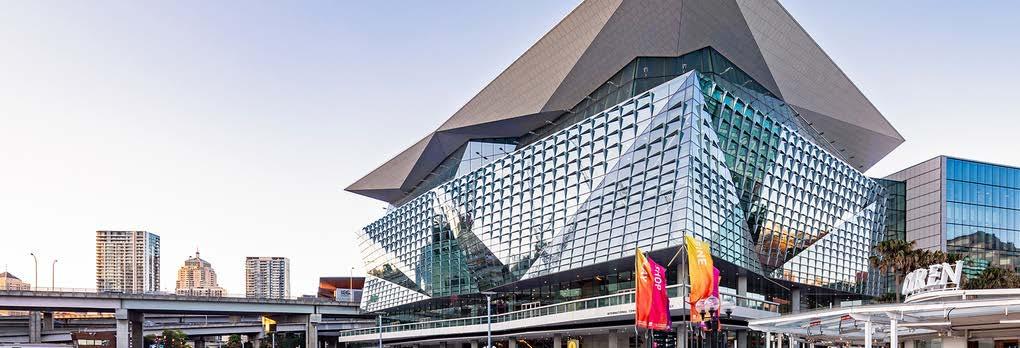



INTERACTIVE ZONE
The exhibition hall will feature an ‘Interactive Zone’ with a stage and seating area, providing an opportunity for exhibitors and sponsors to present ideas, new technologies, and have a bit of fun.
POSTER PRESENTATIONS
Come meet the authors at our designated poster area!
The exhibition space will feature a walk-through poster area along with seating to accommodate for short poster presentations.
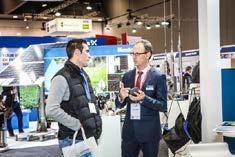
EXHIBITION HALL
NETWORKING LOUNGE
Take advantage of our central networking lounge, which will be located in the heart of the exhibition hall, with informal seating to allow delegates to meet and connect in an informal setting
The exhibition hall will be the centerpiece of the 2024 Conference & Exhibition. This expansive space is where innovation meets opportunity, allowing exhibitors from around the globe to showcase the latest technologies, services, and ideas shaping our industry.
URBAN WATER WORKSHOPCOUNCIL AND IRRIGATION INDUSTRY PARTNERSHIPS
Participate in an Urban Water Workshop and training sessions to help drive smarter installation and system management, ensuring better bang for the public dollar
WOMEN IN WATER PANEL SESSION
Share valuable insights and nurture partnerships!
Join us for the Women in Water Breakfast and panel session on Tuesday the 2nd of September to connect, empower, and celebrate with fellow females working in the irrigation and drainage industry.

PRINCIPAL SPONSOR


CONTACT


TECHNICAL TOURS
Explore technical tours highlighting the latest innovation in Sydney, in partnership with Sydney Water and other hosts IN SYDNEY
MULTIPLE PLENARY SESSIONS
Scan here to view the full preliminary program!

Join leading experts, industry pioneers, and visionary thinkers as they share insights on the latest advancements, trends, and challenges in the irrigation and drainage industry.
Each plenary session is designed to provide a comprehensive understanding of the critical issues facing our water management systems today.





PRINCIPAL SPONSOR MAJOR SPONSORS FULL PROGRAM NOW LIVE Register for the event here!
Irrigation Australia Ltd (07) 3517 4000 irrigation2024@theeventgap com au The Event Gap (02) 8607 1413 irrigation2024@theeventgap com au
MAJOR SPONSORS
FULL CONFERENCE PROGRAM NOW LIVE! REGISTRATIONS CLOSING 16 AUGUST 2024 CONFERENCE & EXHIBITION CONFERENCE & EXHIBITION 2 - 4 September 2024 2 - 4 September 2024 || ICC Sydney ICC Sydney 75th 75th IEC MEETING IEC MEETING ASIAN REGIONAL CONFERENCE ASIAN REGIONAL CONFERENCE 9th 9th Irrigation & Drainage Irrigation Drainage
- 7 September 2024 1 7 September 2024 || ICC Sydney ICC Sydney I C I D C I I D
1

IRRIGATION AUSTRALIA NEWS
WELCOME, ABBY MCCORRISTON!
We are thrilled to introduce Abby, our new junior administrator at Irrigation Australia.
Abby has a professional background in retail and administration, with a focus on finance and organisational management. She is always looking for learning opportunities and excels at problem-solving, quickly identifying issues, and implementing effective solutions to meet organisational objectives.
As a junior administrator at Irrigation Australia, Abby handles incoming calls and email inquiries, builds and maintains relationships with key stakeholders, and manages document scanning, filing, and databases. She is also responsible for managing office supplies and mail, engaging with members, and ensuring the timely delivery of documents, information, and certificates. Additionally, Abby supports Rebecca in the WA office and assists the rest of the team as needed.
Abby said that while she has plenty to learn about the irrigation industry, she is up for the challenge.
“I’m really looking forward to diving into the irrigation industry and being a part of its growth. I’m especially excited about being involved in sustainable water management as it is vital for both the environment and agriculture. I can’t wait to see how innovative irrigation technologies make a real difference in communities.”
Outside of work, Abby enjoys a range of hobbies. She is passionate about fitness and enjoys running, often with her father or her two beloved Weimaraner dogs. Abby is also an avid reader and a self-proclaimed foodie, always on the lookout for new books and culinary adventures.
We are delighted to welcome Abby to the team.

DO YOU KNOW AN OUTSTANDING IRRIGATION PROFESSIONAL OR BUSINESS?
We’ve introduced a series of new awards that will be presented at this year’s conference, and nominations are open now.
The new award process is meant to be quick and easy. Click here for more details. Categories are as follows:
• Water Efficiency Management Awards – Categories for Individuals, small businesses and large businesses.
• Innovation in Sustainability Awards – Categories for individuals, small businesses and large businesses.
• Emerging Leader Award – One individual.
• Innovation in Safety Awards – Categories for individuals, small businesses and large businesses.
And don’t forget, you can also nominate for the longstanding MacLean-Iedema Award, here
Nominations for all awards close at the end of July, so be quick.
GREAT TURNOUT FOR MEMBER EVENT IN WA
Western Australian members were recently treated to a fantastic member event at the Vines Resort in the Swan Valley, which has recently replaced its irrigation system. Members were eager to hear about this massive collaborative project from the Golf Course Superintendent, Western Irrigation, Rain Bird Corporation, and Living Turf.
A big thank you to all participants and presenters for making this event a success. To learn more about these site topics, check out part two of this project in the upcoming Winter issue of The Overflow magazine.
Special thanks to Western Irrigation for capturing amazing drone footage of the event.
To view photo and video of the event, click here
Do you have a great idea for a member event? Do you want to share your work with our members? Contact Rebecca New, membership manager at Rebecca.new@ irrigation.org.au or 08 6263 7774.
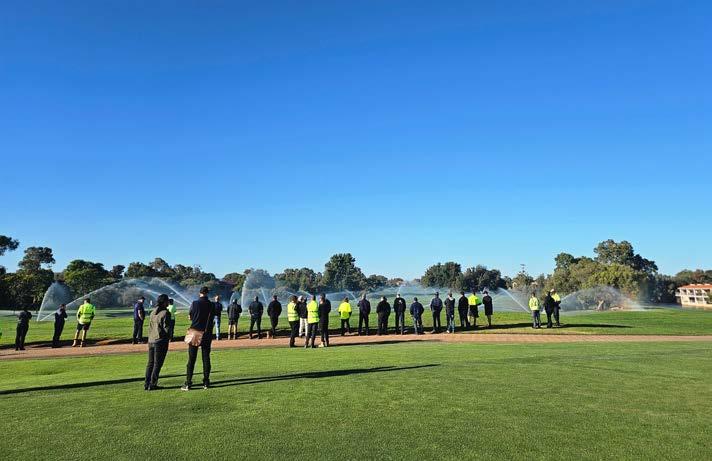
WINTER 2024 33
IRRIGATION AUSTRALIA NEWS
STUART ALEXANDER MAKES FINALS OF QUEENSLAND TRAIING AWARDS
We are excited to announce that Stuart Alexander, our Senior Trainer and Assessor at Irrigation Australia, has been recognised as a top three regional finalist for VET Teacher or Trainer of the Year in Queensland!
Those that have had the opportunity to work alongside or learn from Stuart would join us in celebrating his dedication, passion, and exceptional contribution to vocational education and training within the irrigation industry.
It’s great to see someone who has done so much for the industry being recognised for his outstanding efforts over the years.
The winner will be announced in early July, so keep an eye on social media!
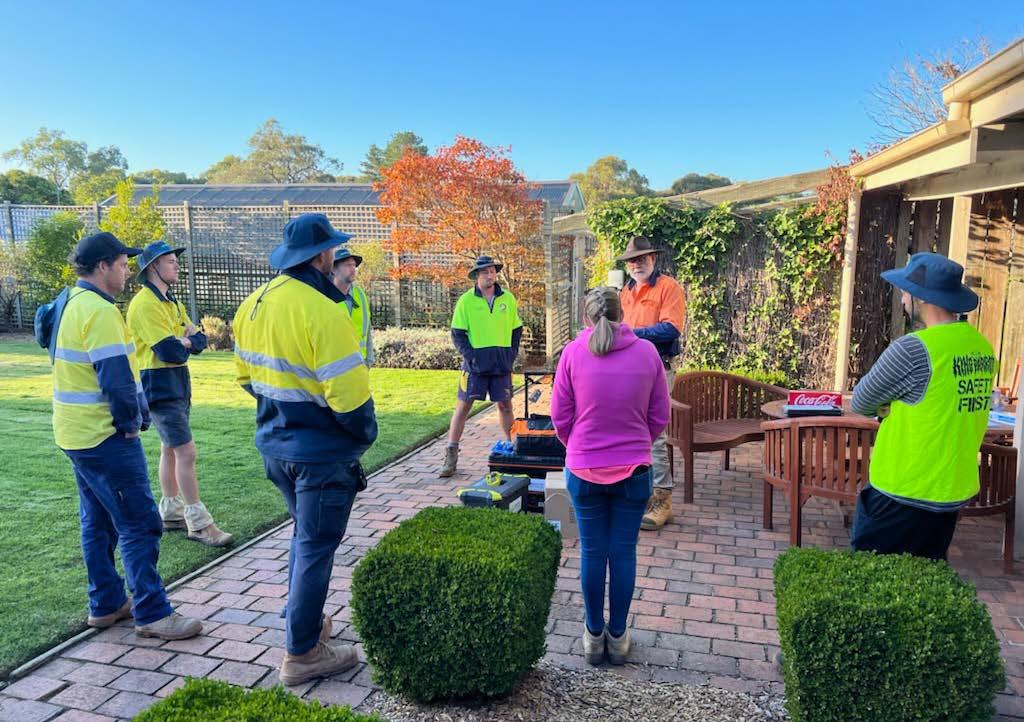
Want to know more about certification?
Download the certification guide from the Irrigation Australia website.

WATERWISE IRRIGATION PROGRAMS ON FACEBOOK
Have you checked out Irrigation Australia’s Waterwise irrigation programs on Facebook? There are two categories:
• Waterwise Garden Irrigator - for professional installation and maintenance services
• Waterwise Irrigation Design Shop - for expert advice and quality parts
The Facebook page aims to provide the wider community with #waterwise tips and advice and promote members.
Use the QR code and jump on Facebook to find out more and keep up to date.




IAL BOARD DIRECTORS
Treptow (Chair)
Irrigear Stores, Mornington Victoria 3931
Valentina Tripp (Deputy Chair)
Individual member, Vic
Peter Brueck
Waterwise Consulting, Bangor, NSW
Greig Graham
Rivulis, Brendale, Qld
Rob Nadebaum
Rain Bird, Deer Park, Vic
Matthew Binder
Individual member, SA
Carl Walters
Goulburn Broken Catchment Management Authority, Shepparton, Vic
Clinton Hort
Rodney Industries, Chermside, Qld
Gennaro Vellotti
Netafim Australia/New Zealand, Adelaide, SA
Paul Smith
Pumps ‘N’ Pipes Supplies, Mandurah, WA
34
Click Here GET RECOGNISED FOR YOUR SKILLS & KNOWLEDGE Certification
Simon
Many readers will be familiar with Stuart Alexander (in orange shirt) and his exceptional skills as a trainer.
MEMBERSHIP BENEFITS

1. Irrigation Journal Copies
Distributed quarterly in digital format, Irrigation Australia’s signature publication, the Journal, contains valuable industry information about new projects, technologies and techniques for Agriculture, Landscape & Domestic Irrigation.
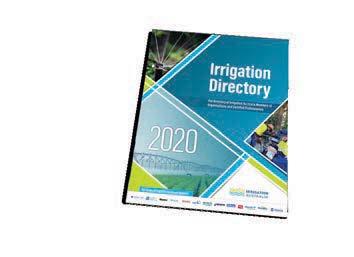
2. Access to the National Irrigation Directory
The only national and comprehensive digital directory where you can find details about irrigation retail businesses, manufacturers, installers, contractors, certified professionals.
3. Training Discounts
Receive significant member discounts on nationally accredited irrigation training and qualifications delivered by Irrigation Australia in city and regional areas and on line virtually.
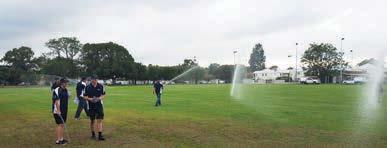
4. Certification Discounts
Receive significant member discounts on the joining fee and renewal fee to the Certification Program administered by Irrigation Australia.
Certification is a national program of industry recognition. Certification adds instant credibility with customers, increases job opportunities and demonstrates your commitment to efficient water management. Visit our website to learn more www.irrigationaustralia.com.au

5. Conference & Tradeshow Discounts
Member discounts on attending and exhibiting at the Irrigation Australia Biennial International Conference & Exhibition.
6. Members Only Portal
Gain access to the members only portal on the Irrigation Australia website. Through the portal you can manage your Irrigation Australia membership, register your staff/employees for training, access members only documents, presentation and other materials.
7. Access to eKnowledge
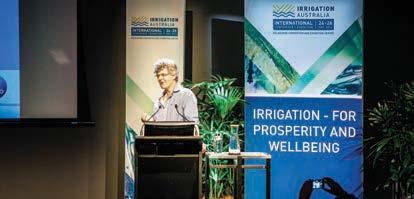
11. International Representation
Be par t of the global irrigation community and gain access to international contacts via the Irrigation membership of the International Commission on Irrigation and Drainage (ICID).
12. Discounts on Waterwise endorsement

Irrigation Australia eKnowledge repository has significant resources of technical papers, conference papers, Irrigation Journals and FAQ’s available only for Members.
8. Discounts on Publications and Merchandise
Irrigation Australia offers a wide range of books, eBooks and other merchandise through its online store. Members receive significant discounts on materials.

9. Invitations to Regional Meetings & Events
Irrigation Australia hosts a number of regional meetings, events and site visits across Australia. This is a great opportunity for members and industry colleagues to come together to discuss new challenges, technologies and network.
Receive our monthly Irrigation E-News with the latest information on upcoming training, events as well as new products, information and industry news.
Receive significant member discounts on the Waterwise endorsement programs, relevant for domestic irrigation contractors, installers, landscapers and retailers. Benef it from Waterwise marketing and merchandise to promote yourself as a Waterwise irrigation professional to the community.

See www.waterwiseprograms.com.au for more information.
Additional Membership Benefits
(EXCLUDES PRIMARY PRODUCERS, INDIVIDUALS & RETIRED MEMBERSHIP CATEGORY)
13. Free Listing in the online National Irrigation Directory
List your business for free with digital copies reaching the wider irrigation industry which attracts significant page views every month
14. Free Online Job Listing
List your upcoming job vacancies on Irrigation Australia’s online job board which attracts significant targeted views every month.
15. Free Listing on Irrigation Australia’s Website
List your business on Irrigation Australia’s Website Directory “Find an Irrigation Specialist” on the front page of our website www.irrigationaustralia.com.au
16. Advertisement Discounts on Irrigation Australia Publications
Receive significant discounts on advertising in the Irrigation Journal. The Irrigation Journal is distributed each quarter to all members and industry contacts
10. Monthly Electronic E-News
FOR MORE INFORMATION, CONTACT IRRIGATION AUSTRALIA ON: T 1300 949 891 | E info@irrigation.org.au | W www.irrigationaustralia.com.au | QLD: Unit 11/58 Metroplex Avenue, Murarrie, QLD 4172 | PO Box 13, Cannon Hill QLD 4170 WA: First Floor, Unit 2, 26 Hammond Road, Cockburn Central WA 6164 | PO Box 3401, Success WA 6964 To Become a Member of Irrigation Australia Join online by visiting www.irrigationaustralia.com.au or contact us at 1300 949 891 or email info@irrigation.org.au
PROFESSIONAL DEVELOPMENT
IRRIGATION AUSTRALIA TRAINING

A training update by Sam O’Brien, Training and Compliance Manager
We are pleased to announce that the training schedule for the 2024/2025 financial year is now finalised. We are looking forward to increased participation and feedback on our improved and updated shorter courses: 'Certified Irrigation Installer' and 'Certified Irrigation Operator'.
These courses include accredited units from the full Certificate III in Irrigation Technology and are recognised skillsets. They are designed to offer a more self-paced learning journey while keeping the goal of full certification in mind.
Additionally, we will be delivering newly reviewed and refined courses: 'Irrigation Pumps and Systems' and 'Centre Pivot and Laterals.' These shorter three-day courses also include accredited units from the full Certificate III in Irrigation qualification.
To provide more information, we have created one-page flyers for each course offered in 2024/2025. These flyers include all the relevant details around delivery dates and locations, pricing, course description and funding opportunities. Please reach out directly if you would like more information on any of these updated courses.
You can also check the Irrigation Australia website for monthly information on course deliveries. Event Listing Training (irrigationaustralia.com.au)

Federal Budget: Funding for apprentices and employers
The government will invest a further $265.1 million over four years from 2024-25 for the Australian Apprenticeships Incentive System, to continue supporting apprentices in priority occupations.
Under the revised Australian Apprenticeship Incentive System:
• Apprentices undertaking training in priority occupations will be eligible for $5,000 to assist with cost-of-living and incentivise them to finish their training.
• Employers taking on apprentices in priority occupations will be eligible for $5,000 to help subsidise costs associated with employing an apprentice.
• This list includes both the Certificate III Irrigation Technology and Certificate IV Irrigation Management.
TRAINING DIARY
12 to 16 August 2024 Certified Irrigation Installer Brisbane, Qld
20 to 22 August 2024 Meter Installation & Validation Goondiwindi, Qld
19 to 23 August 2024
26 to 30 August 2024
Certificate III in Irrigation Technology AHC32422 QLD Brisbane, Qld
Certificate III in Irrigation Technology AHC32422 - NSW Paterson, NSW
IRRIGATION TRAINING INFORMATION AT YOUR FINGERTIPS
Check out Irrigation Australia’s training course booklet This comprehensive publication provides essential details on training courses offered by Irrigation Australia.
• Certificate III in Irrigation Technology
• Certificate IV in Irrigation Management
• Centre Pivot and Lateral Move
• Meter Installation and Validation
• Introduction to Irrigation | Agriculture
• Introduction to Irrigation | Urban
• Irrigation Pumps and Systems
• Irrigation Efficiency
• Urban Irrigation Design
• Commercial Irrigation Design
• IRRICAD Design
• Irrigation Installer
• Storage Meter Installation and Validation

36
DATE COURSE LOCATION
A recent training session at Tocal Ag College.
FROM TEACHER TO STUDENT: NATALIE’S CAREER PATHWAY
Natalie Morris, office manager at Superior Irrigation in Gatton, Queensland, is a very busy woman. She is also proof that a career in irrigation can work for anyone, regardless of their professional background and lifestyle.
Last year, Natalie switched from a career in education to irrigation. She is now involved in every aspect of the familyrun irrigation business, including helping with installation jobs. Not only that, but she is also currently completing her Certificate III in Irrigation Technology and is mum of seven children!
Irrigation Australia Journal asked Natalie about her experiences so far in the irrigation industry, her views on training, and how she manages her busy life.
IA. How did you end up in the irrigation industry?
Natalie. In education, my main role was as an educator in an early years and kindergarten centre. During COVID, my role became obsolete for a time, and I enjoyed being a stay-athome mum.
My stepdad owns Superior Irrigation Services in the Lockyer Valley. In 2023, he asked if I’d like to work there. I took the opportunity for a career change, partly because it would give me flexibility around my family life.
IA. Can you tell us about your current role?
Natalie. I’m ‘office manager’, but this entails many roles! I answer the phones and do the business admin tasks; I am a salesperson and I re-order stock; I am the point of contact for suppliers; I re-stock our display room and warehouse; I’m the cleaner; I manage the advertising and social media; and I sometimes go out on on-site to help with installation jobs.
IA. Can you tell us a bit about the training you’ve done with Irrigation Australia?
Natalie. I’ve completed the Introduction to Irrigation short course and am currently completing my Certificate III in Irrigation Technology. I’m the only woman in my Cert III group, and one of the oldest students. It was daunting at first, but I am in a group of supportive male peers who have been welcoming and helpful. We all get on well and have a group chat where we share advice and information. I enjoy the hands on/technical work in the course. I surprised myself during an assessment by effectively and efficiently solvent-welding PVC pipe together on my first attempt. I’d never done anything like that before!
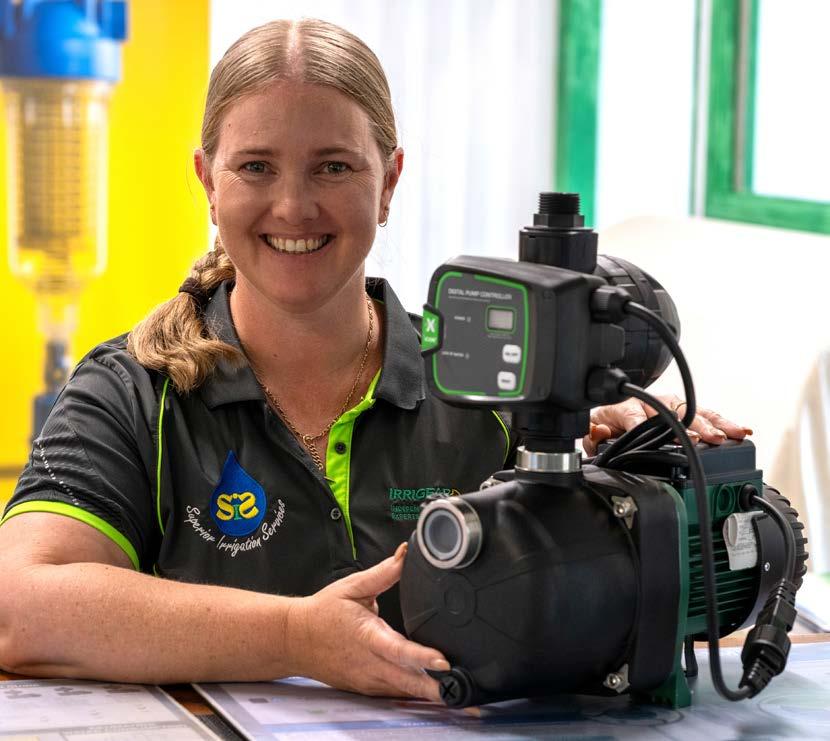
So far, the Cert III appears to be directed more at people who go out on site every day, whereas my role is mostly in-store, but I like learning about all aspects of the industry. Having this knowledge gives me confidence and helps when communicating with customers.
IA. With a large family, how do you balance work and family life?
Natalie. I have seven children and it can be a juggling act. Between three different schools, multiple sports and afterschool jobs, life must be well planned! We have weekly meal plans and timetables and travel plans for each day. Everyone has their own chores.
I currently have Wednesdays at home with my four-yearold and get some housework done. Sundays are for family time. We value that time to re-group and prepare for another week.
IA. What’s it like to be a woman in a male-dominated industry?
Natalie. This has been the biggest eye-opener. The irrigation industry is still male dominated. People get a shock when they walk into the store, when they hear a woman on the phone or when I turn up at an installation job. People sometimes assume that because I am female, I have no idea about irrigation. “Can I please speak to a man?” is a common phrase I hear.
WINTER 2024 37
IRRIGATION FOR SAFETY AND ANIMAL WELFARE AT GREYHOUND RACING CLUB
SNAPSHOT
• A prominent greyhound racing club in Victoria recently underwent a comprehensive upgrade to improve public safety and animal welfare.
• Brown Brothers Engineers supplied a new automated irrigation system, consisting of a booster pump-set with a custom control panel.
• The new installation has provided efficient and reliable performance and ensured optimal irrigation and safety of the greyhound racetrack.
When most people think of irrigation, they think of its role in supporting plant life – crops, turf or urban green space. However, another important role of irrigation is to improve public safety and animal welfare, such as on sand tracks used for greyhound racing.
Sale Greyhound Club, one of the most frequently used racetracks in Victoria, recently undertook a comprehensive upgrade. Before this upgrade, the club lacked an irrigation system. The track managers relied on a water cart pulled by a tractor to wet the track, which meant considerable time and cost in labour.
Track manager, Gary Roberts said, “Some days, we’d have the bloke here for eight hours at a time putting water on the track”.
An important aspect of the upgrade was a new stateof-the-art irrigation system supplied by Brown Brothers Engineers Australia.
Irrigation for safety
Consistent watering of sand tracks is important to ensure that the track surface remains firm yet cushioned, reducing the risk of injuries to racing dogs. Watering also regulates temperature, maintains an even surface and prevents erosion. This reduces the chance of accidents and enables the greyhounds to perform at their best. A moist track also means less dust and debris, which can impair visibility and cause respiratory issues for both dogs and handlers.
Selecting the right pump
The project consultant selected the 22DSV05HPS-T 5.5kw 415v Lowara Hydro-Pac Dual Booster pump-set for its ease of installation – meaning less disruptions – and its quality and reliability. The pump was sized by Brown Brothers Engineers.
The Hydro-Pac units combine the pumps with a Hydrovar microprocessor controller mounted directly on each pump motor to deliver an energy-efficient water management system that is simple to use.
A custom-built INCA control panel was also supplied to manage the dual pump-set. The panel includes an array of safeguards, ensuring the reliable operation of the pumping system. Circuit breakers are individually allocated for each component, including the pumps, surge diverters, and control circuits, providing protection against electrical faults. A main isolating switch allows for immediate power isolation when necessary. To mitigate the risks posed by electrical surges, 40 kA surge diverters are installed across the power supply while temperature sensors are included for monitoring pump head temperature. These safeguards collectively reinforce the integrity and longevity of the pumping system and guard against damage or potential failure.

38 ARTICLE
Consistent watering of sand tracks is important to ensure that the track surface remains firm yet cushioned, reducing the risk of injuries to racing dogs.

An efficient solution
The racecourse has now re-opened and the pumps have proven to be ideal due to their high efficiency, flexible design and reliable performance.
Gary, the track manager, said that they water every day, as often as needed depending on weather conditions. The sprinklers are evenly spaced at three metre intervals. On the inside of the track, they are on the running rail; along the fence line, they are on the outside edge; and there are popups along the home straight.
There are 15 stations, each about 100 m long. According to Gary, a three-minute cycle per station is enough to evenly wet the track. After that, they run 20 second cycles as needed throughout the day.
Gary says he appreciates being able to control the irrigation remotely, any time, from an app on his phone.
“Sometimes, depending on the weather, we need to irrigate overnight, and it’s great being able to do it all from my phone.”
“The new system is easy to use and saves a lot of time and money in labour,” he said.
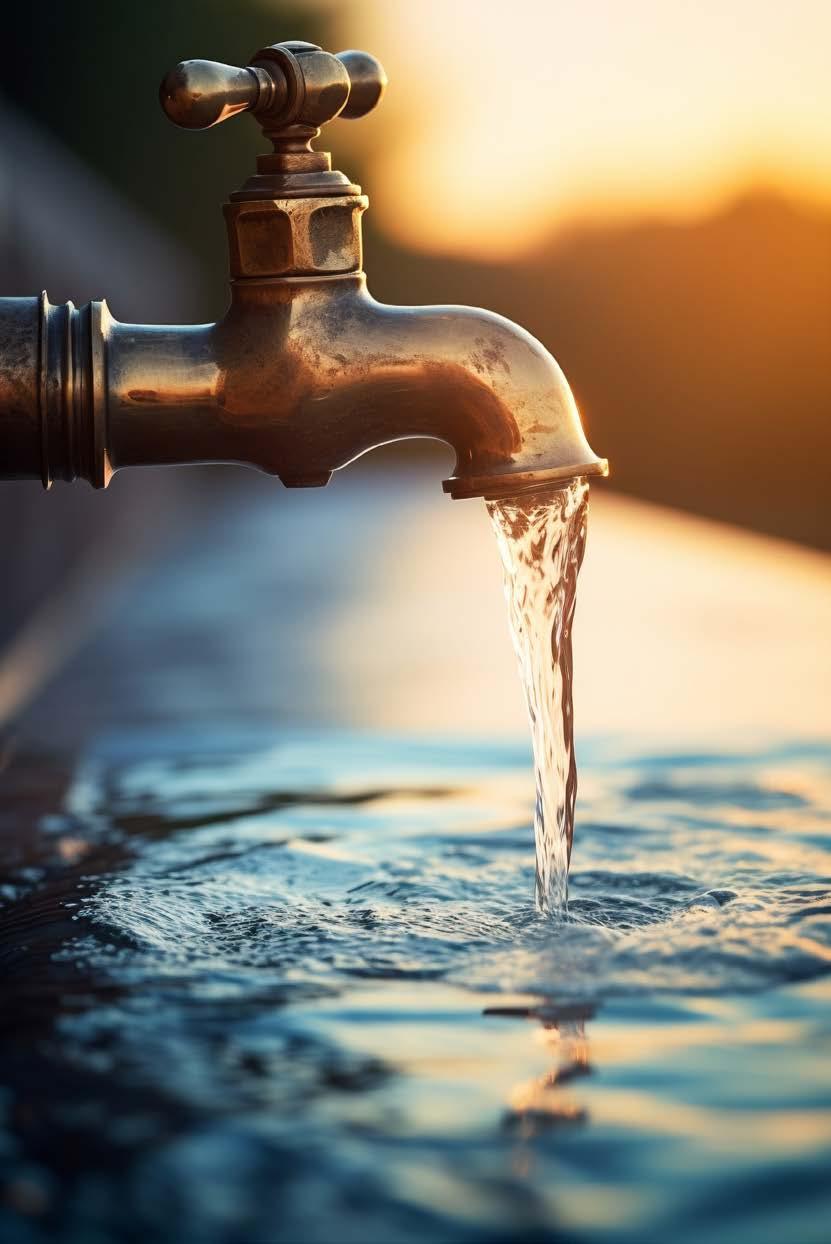
INCONSISTENT STATE LAWS LEAD TO DROPPED WATER THEFT CASES
Water theft in the Murray-Darling Basin is costing the environment and taxpayers who fund essential environmental flows. The basin's water, valued at nearly A$100 billion, is crucial for species habitats and agricultural irrigation. Federal investments in environmental water rights are undermined when agricultural users exceed their entitlements, stealing water and diminishing already stressed river systems.
The Murray-Darling Basin Inspector General of Water Compliance, Mr. Troy Grant, revealed that inconsistent state laws across Queensland, New South Wales, Victoria, South Australia, and the Australian Capital Territory lead to dropped water theft cases. In February 2023, 62 cases were dropped due to poor legislative support and inconsistent enforcement.
A study led by Associate Professor Adam Loch at The University of Adelaide highlights these legal inconsistencies and their impact on environmental water protection. As droughts and climate change reduce water availability, theft may increase, further stressing ecosystems.
The research recommends a ‘pyramid’ approach to standardise penalties across states, ensuring more severe consequences for significant offenders. Consistency in compliance and prosecution is crucial to protecting environmental flows and maintaining water rights security. Addressing these issues promptly is vital as climate projections indicate declining water flows, risking catastrophic impacts on the basin's water systems by 2060-2080.
Source. Biodiversity Council website.
Article supplied by Brown Brothers Engineers Australia
The new pump-set.
TECHNOLOGY FOR EFFLUENT IRRIGATION: HELPING DAIRY FARMERS MAKE INFORMED DECISIONS
SNAPSHOT
• Effluent from dairy farms is increasingly being seen as a valuable resource, rather than a waste product. It can be returned to the fields as fertiliser, saving farmers thousands of dollars each year.
• However, effluent irrigation has to be managed carefully to avoid waste and risks to the environment and animal health.
• Until recently, farmers lacked data to guide them in decisions around when to apply effluent irrigation and how much to apply.
• CropX has developed a system based on soil sensors and pond level sensors that send data to an app. It provides farmers with real-time data and advice to help with irrigation decisions.
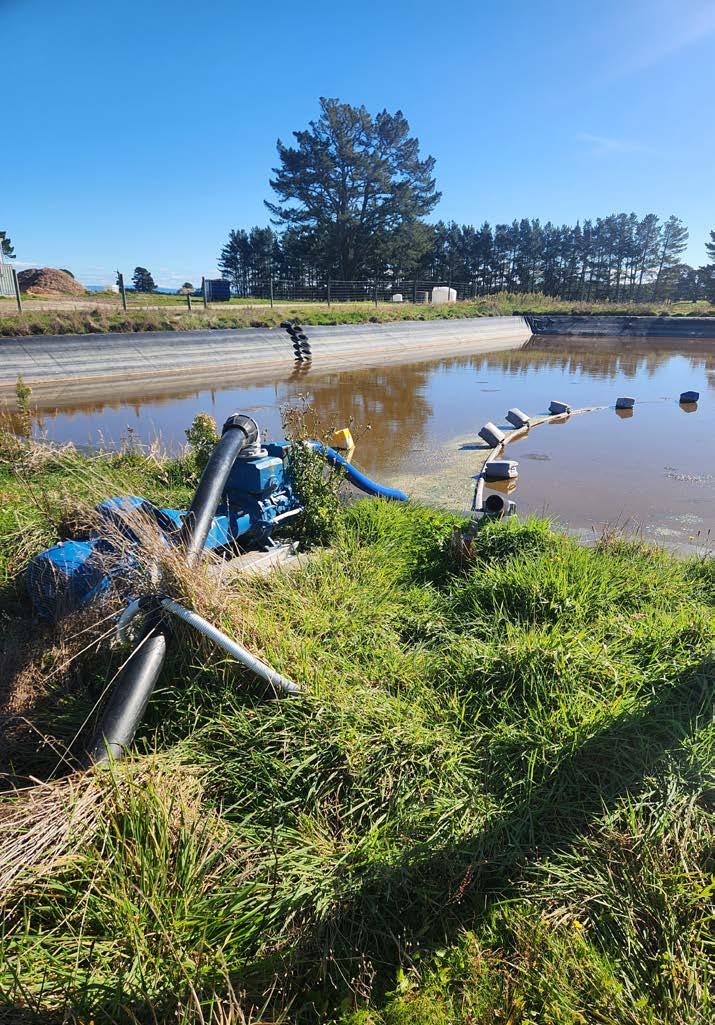
New technology can help farmers decide when to deliver effluent irrigation and in what quantity.
On dairy farms, effluent is a valuable source of nutrients that have been already ‘paid for’ via the animal feed that has been consumed and passed through the animals. Following a period in storage ponds, effluent can be used to irrigate crops or pasture. However, to avoid waste and environmental impacts, it must be delivered at the right time and in the right quantities. A new app helps farmers achieve this.
Timing and amount of effluent irrigation
Effluent contains phosphate, nitrogen and potassium, all of which are needed for plant growth. However, applying too much at the wrong time is not only wasteful but it can also lead to environmental and animal health problems.
Potassium. If effluent is applied to land that will be grazed by cattle, the levels of potassium must be managed, as buildup can lead to serious animal health issues.
Nitrogen. Nitrogen is easily soluble in water. If effluent is applied to land that is close to saturation, or just before rain, the valuable nitrogen can leach through the soil and be lost. Leaching also affects water quality in aquifers and waterways, a major environmental issue.
Phosphate. Phosphate is not washed through the soil but, like nitrogen, if soils are wet and the effluent does not have time to soak in, it can move overland into waterways, affecting the water quality.
In addition to looking after their own land and animals, farmers also need to comply with regulations and industry standards relating to effluent management.
Monitoring and managing soil conditions
These potentially negative consequences can be managed by carefully monitoring soil conditions and applying effluent irrigation at the right time. However, farmers generally lack data to guide these decisions. Consequently, most standard effluent systems lose an estimated 20 per cent of their applications to runoff and leaching. This is not only a waste of money but is also bad for the environment.
Bridgit Hawkins, chief sustainability officer at CropX, said, “Generally farmers either don’t consider soil conditions or use a basic rule of thumb, such as X days after rainfall. Most impacts from effluent use – positive and negative – are not immediately visible, so there is limited feedback for farmers.”
40 ARTICLE
Case study: Westfield Farms
Westfield Farms in New Zealand has been using the soilmoisture-sensor enabled effluent management system developed by Hawkins since 2015. New Zealand’s robust regulations, which are very similar to Australia’s, require farmers to keep detailed records, and incentivise the absence of effluent ‘incidents’, such as pond overflow, effluent ponding in a field where the soil is too wet, or effluent draining to a drain or waterway. Success is defined as an absence of incidents, not mere reduction, and an effective record-keeping system that makes the data easy to report to the local council or offer to a visiting auditor.
Westfield Farms uses soil moisture and pond level monitoring across four dairy farms. Janene Dickson, owner of Westfield Farms, said, “Using an integrated monitoring and recording system has streamlined effluent management by allowing us to keep good records of effluent applications, maintain good soil conditions and ensure that pond levels are always where they need to be.”
Data to inform decisions
Bridgit set about to develop a system that gives farmers data to help them use effluent as a valuable source of nutrients while staying within the regulatory framework.
Bridgit together with Massey University of New Zealand conducted studies that confirmed that nutrient leaching can be reduced by applying effluent irrigation only when the soil has the capacity to retain the nutrients.
Backed by this knowledge, she developed a system that uses soil moisture sensors and pond level sensors connected to an app. The app offers real-time data on the status of both the effluent ponds the fields that are being irrigated with effluent, and makes recommendations on effluent irrigation and pond level management.
The system, called CropX Effluent Irrigation, tracks the soil moisture status of the field and the effluent pond level status in comparison to the full point (optional and customisable). Based on that data, CropX Insights gives quantified effluent irrigation advice – whether it is safe to irrigate, and if so, how much (in mm). In addition, it can perform a 14-day review of good management practices when used with an optional pump activity sensor.
A paradigm shift in effluent management
As farmers are searching for ways to make their farms financially and environmentally sustainable, effluent is moving out of the ‘waste’ category.
“Returning the nutrients to the soil for plant growth is worth thousands of dollars for a farmer each year in fertiliser value,” Bridgit said.
At the same time, regulations are starting to recognise the environmental risks of poor effluent management – where it has been treated as waste product – and are increasingly requiring farmers to have systems in place to minimise environmental impacts. For a farmer, this means having a good system that is informed by real-time data not only saves money but also stress and hassle in ensuring the regulations are met.
Information. To find out more, visit the CropX website here

The app gives the farmer real-time data and recommendations to help with effluent irrigation decisions.
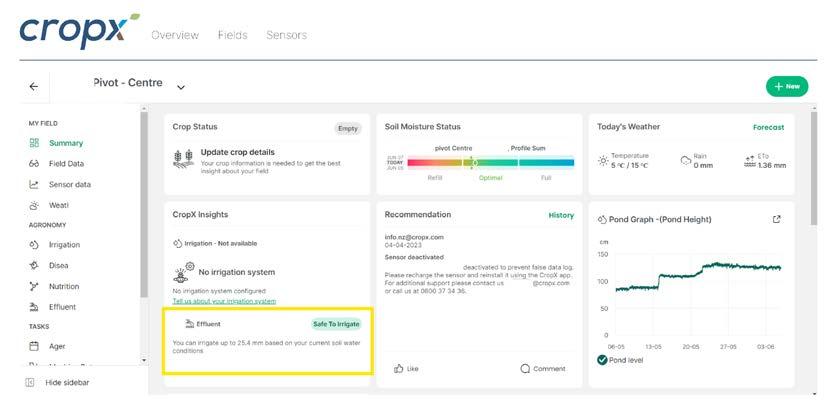
WINTER 2024 41 Article supplied by CropX

PREPARING FOR THE 9TH ASIAN REGIONAL CONFERENCE ON IRRIGATION AND DRAINAGE
The Australian National Committee of ICID (IACID) has been focused on organising the 9th Asian Regional Conference on Irrigation and Drainage and the 75th IEC Meeting of ICID. These events will coincide with the Irrigation Australia Conference from 1 to 7 Sept 2024 at the International Convention Centre of Sydney (ICC).
The theme of the 2024 Asian Regional Conference will be ‘Irrigation’s role in delivering economically viable food security and sustainable urban green spaces, in an increasingly unpredictable climate’.
The world is undergoing a global water crisis, where drought no longer seems to be an emergency, but rather a routine event. Hence, some of the key questions that the scientific community and decision makers are repeatedly being asked, all over the world, are:
• What consequences are the recurrent droughts having on the agricultural sector?
• What will be the social and environmental impact of these?
• Will these extreme events have an impact on food security?
• Is it possible to save water under recurrent periods of drought like the ones we are facing?
These complex questions are on the backdrop of the effects of climate change, increasing production costs, and a pressing need for energy sustainability.
This important event brings together scientists and researchers, international organisations and political leaders from ICID member countries to exchange knowledge and insights around these big issues.

42 ICID INSIGHTS
This event brings together researchers, international organisations and political leaders from different countries; we are all facing a water crisis.
SPEAKER SPOTLIGHT: LIFT IRRIGATION IN NEPAL

Dr Santosh Kaini will be speaking about the sustainability and lifecycle cost of solar and electric lift irrigation schemes in Nepal.
One presentation that embodies the conference themes and has wider application to many parts of the world is by Dr Santosh Kaini (Joint Secretary) from the Government of Nepal.
Background
Farmers in the mid-hills of Nepal lack a year-round water supply for irrigation, a challenge that is worsening as the climate becomes drier. A solution to this is lift irrigation, where water is mechanically lifted from a lower elevation water source
to higher ground, an approach that has wider application to many parts of the world. Dr Santosh Kaini will be presenting the findings of a study that assesses the sustainability and lifecycle costs of solar and electric lift irrigation schemes.
What are the key messages from your presentation?
• Based on Analytical Hierarchy Process (AHP) results, the technical dimension is the most influential followed by environmental, socioeconomic, and institutional dimensions for sustainability of lift irrigation projects.
• Electric lift schemes with an average cost of AUD 0.08/m3 of water are found more cost-effective compared to solar lift schemes with an average cost of AUD 0.2/m3 of water over a 20-year lifespan.
• To lower the operation and maintenance cost of electric lift schemes, it is critical to optimise the designs of both pumps and intake structures that enhance the scheme's performance.
• To reduce the lifecycle cost of solar lift schemes, the government could subsidise the cost of solar panels and pumps.
Why can other countries learn from your work in Nepal?
• This work addresses issues relating to technical, environmental, socioeconomic and institutional aspects of lift irrigation schemes, which will be relevant to many regions of the world.
• Our methodological approach for lifecycle cost assessment of solar and electric lift irrigation schemes could be applied globally.
• Overall sustainability issues and lifecycle cost of solar and electric lift irrigation schemes apply to other countries too.
What are you most looking forward to at the conference?
I’m looking forward to learning more about global issues in irrigation development and management and networking with industry and academic irrigation professionals. It’s a great opportunity to exchange knowledge, skills, and expertise with professionals from diverse backgrounds and industries globally. I’m also looking forward to seeing the cutting-edge products and services at the exhibition.
Santosh’s presentation is ‘Investment in irrigation in the climate change context: Sustainability and lifecycle cost assessment of solar and electric lift irrigation schemes in Nepal’. The paper's co-authors are Dhiraj Lamsal, Pratik Singh Thakuri.
EVENT SCHEDULE
DATE EVENT LOCATION CONTACT/ INFORMATION
1 to 7 September 2024
75th International Executive Council Meeting and 9th Asian Regional Conference
1 April 2025 11th International Micro-irrigation Conference
14 to 15 April 2025
6th African Regional Conference on Irrigation and Drainage
7 to 13 September 2025 76th International Executive Council Meeting
Sydney, Australia http://www. irrigationaustralia. com.au/
Baghdad, Iraq ICID Congress | International Commission on Irrigation & Drainage (ICID) (icid-ciid.org)
Abuja, Nigeria ICID Congress | International Commission on Irrigation & Drainage (ICID) (icid-ciid.org)
Kuala Lumpur, Malaysia ICID Congress | International Commission on Irrigation & Drainage (ICID) (icid-ciid.org)
IRRIGATION AUSTRALIA'S COMMITTEE ON IRRIGATION AND DRAINAGE (IACID)
Momir Vranes (Chair)
Dave Cameron P: +61 7 3517 4001, E: dave.cameron@irrigation. org.au
Naomi Carragher
P: +61 7 3517 4002, E: naomi. carragher@irrigation.org.au
Peter Hayes
Eddie Parr
Carl Walters
Richard McLoughlin
Karlene Maywald
Michael Scobie
Claire Miller
Amin Machiani
Andrew Ogden
Zara Lowien
WINTER 2024 43
BUSINESS
BEYOND THE BASICS: ADDITIONAL SKILLS FOR RETAIL STAFF
SNAPSHOT
• In this era of technological change and low consumer confidence, retailers can benefit from ensuring shopfloor staff have additional skills that go beyond technical knowledge and sales skills.
• This article discusses some skills you may not have considered, and how they might benefit your business.
• Additional skills include: understanding new technology, awareness of social media and marketing trends, visual merchandising skills, an awareness of sustainability, foreign language skills and soft skills.
Retail managers in the irrigation industry understand the importance of a skilled and adaptable team with strong core skills. However, in our changing technological landscape and with consumer confidence at a low, your retail business might benefit from ensuring staff have additional skills that you may not have considered.
Understanding new technology
The retail landscape is being reshaped by AI. From chatbots providing customer service to automated stock management systems, understanding AI and its applications is becoming increasingly important. Retailers will need to equip their teams with a basic understanding of AI concepts like machine learning and natural language processing. This will help them grasp how AI can best be used in retail and the potential benefits it offers.
To help teams master AI fundamentals, data literacy and AI-management skills are necessary. This is the future of retail, and training sessions and webinars will help retailers showcase real-world examples of AI applications in retail. This could include ways to recognise trends in the AI data, personalised product recommendations powered by AI, or AI-driven demand forecasting to optimise inventory management.
Awareness of social media and marketing trends
In keeping with AI trends and much-needed digital aptitude, familiarity with social media platforms, online marketing trends, and basic e-commerce concepts can be an asset for shopfloor staff. For this, retailers can set up team training that leverages digital tools for customer engagement, brand promotion, and online sales optimisation.

44
Great technical knowledge and people skills are important for retail staff, but other skills are valuable too. Photo: photography33 / Deposit Photos.
Visual merchandising skills
Visual merchandising skills help create attractive and customer-enticing product displays. This is a skill that can be taught by focusing on the principles of effective product placement, colour theory, and using the store layout to tell a story.
Awareness of sustainability
Sustainability is a growing concern for consumers, and staff can be empowered to answer customer queries about sustainable practices, eco-friendly products, and recycled packaging. Retailers must ensure that both shopfloor and head office employees are trained to highlight sustainable product features and promote eco-conscious shopping habits.
Foreign language skills
For retailers who own or operate a store in a diverse region, foreign language skills can be a game-changer, allowing staff to connect with a wider customer base and provide exceptional service to non-English speaking customers. There’s an added bonus to having a diverse team that satisfies a diverse customer base: increased loyalty.
Soft skills to look for at interview stage
Soft skills are those essential human qualities that make a retail professional truly empathetic. But it’s not that empathy per se is needed; rather, employees should be able to project themselves into the customer’s shoes, to understand their point of view, to recognise their needs and behaviours.
This, along with a genuine passion for serving customers, means your team will be truly empathetic, attentive, and proactive in anticipating customer needs. This genuine form of empathy, coupled with effective collaboration between teams, means your people can share knowledge and support each other in a way that achieves common goals.
A positive and enthusiastic attitude translates into a positive demeanour, even under pressure. Hire new employees that can help create a welcoming and upbeat atmosphere – not just for customers, but for teammates, too. Remember, the ideal retail professional displays a blend of technical expertise, strong human-centric skills, and the deep conceptual hands-on learning.
Acknowledgment. This is an edited excerpt from an article on the Retail Doctor Group (RDG) website. You can read the full article ‘The tri-skill challenge: Equipping your retail team for success’ here

Free digital training for Australians wanting to upskill
Free short courses in the basics of artificial intelligence, cybersecurity, cloud computing, data analytics and other aspects of digital technology are now available to Australians looking to upskill, start a new career or use the technology in their business operations.
The courses are provided by the National AI Centre (NAIC), coordinated by Australia’s national science agency CSIRO, and the Institute of Applied Technology Digital (IATD).
Find out more and enrol here
Brian Walker is a retail advisor from the Retail Doctor Group. Don’t miss his keynote speech at the Irrigation Australia Conference 2–4 September 2024. Learn more about Brian Walker and the Retail Doctor Group in this video.

WINTER 2024 45
THE WATER CONSERVANCY
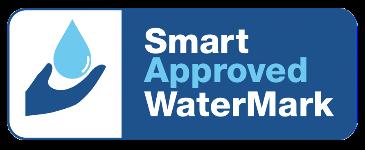
GREENWASHING VERSUS CERTIFICATIONS –ECO LABELS THAT MAKE A DIFFERENCE
Smart Approved Watermark (SAWM) has been the trusted water efficiency label for home and garden products and services for 20 years. The label easily identifies an offering as water efficient and therefore cost efficient in the long term. With the cost of living rising, this little label provides market advantage for businesses; convenience and cost savings for consumers; and streamlines rebate programs for the water industry.
The irrigation industry faces many challenges, but also opportunities. One opportunity is the growing demand for sustainable products and services. Consumers are becoming increasingly aware of how their choices affect society and the environment. Key stakeholders in the irrigation industry, including businesses and councils, also recognise the importance of sustainability. Saving energy and saving water are listed as the second-largest determinants of purchasing decisions (Aussie Intentions: Are They Enough? Australia's Water Literacy Tested, November 2023).
With such an opportunity, some competitors cut corners with misleading sustainability claims. ‘Greenwashing’ is a marketing strategy where businesses use misleading information to convince customers that an offering is providing solutions to environmental problems. This is a blatant breach of social responsibility, as consumers cannot verify the claims but can only hope that businesses are doing the right thing. A recent study showed only 31 per cent of green claims had verification and almost 50 per cent of Australians would stop buying from a business that was involved in greenwashing (The Consumer Experience of Green Claims in Australia, December 2022).
How should irrigation businesses respond?
The ACCC and ASIC are cracking down on greenwashing and imposing harsher penalties on businesses making misleading claims. Irrigation businesses can use this as an opportunity to stand out from the crowd. A trustmark is a great place to start, with consumers being more likely to trust green claims accompanied by a trustmark. Sixty-nine per cent of Australians are likely to be influenced by the presence of a trustmark about a green claim (The Consumer Experience of Green Claims in Australia, December 2022).
Trustmarks can also be misleading, which is why it is important to choose something credible. Smart Approved WaterMark (SAWM) is a trusted label across various
industries in Australia. SAWM verification means the product or service has been tested and proven to create water savings and, in turn, energy and cost savings. Prior to approval, the products and services are also examined by an expert panel with decades of experience.
Smart Approved WaterMark in the irrigation industry
SAWM certifies more than 85 products and services. Examples of certified products under our irrigation category include:
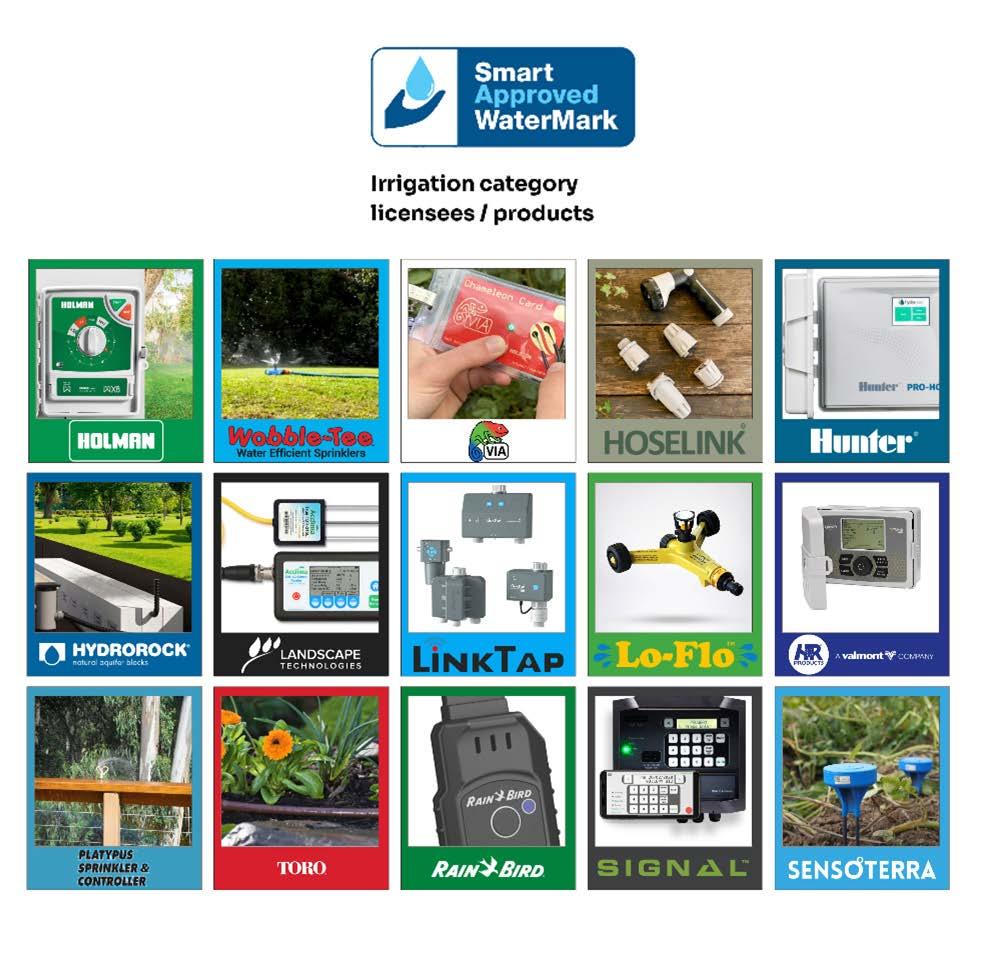
Information. If you have a product or service that meets the criteria, or you would like to find out more go to the Smart Approved WaterMark website https:// smartwatermark.org or view the Frequently Asked Questions. You can also email our Account Manager at michelle.thompson@thewaterconservancy.org. If you’d like to see the portfolio of products click here. Meet The Water Conservancy or visit the website
References.
• The Water Conservancy (2023) Aussie Intentions: Are They Enough? Australia’s Water Literacy Tested. rep. Sydney, NSW.
• Burry, K. (2022) The Consumer Experience of Green Claims in Australia. rep. Consumer Policy Research Centre.
46
STATE ROUNDUP
WHAT DOES THE FEDERAL BUDGET MEAN FOR WATER?
On 14 May 2024, the Treasurer delivered the Federal Budget. Here are the key points for the water sector.
• Buy backs: The government plans to use funds from the 'Water for the Environment and Special Account' in 2024-25. However, the specific amounts for water purchases are not disclosed in the budget due to ongoing negotiations and commercial reasons.
• Socio-Economic Impact funding: Funding is set aside to help Basin states manage the economic impacts of water purchases and implement the Basin Plan reforms. The exact amounts are not disclosed due to ongoing negotiations and commercial reasons, extending to the 2025-26, 2026-27, and 2027-28 budgets.
• Water market regulation: $5.7 million is allocated over two years to support the Australian Competition and Consumer Commission (ACCC) in regulating the water market.
• Basin Plan delivery: $217.3 million is allocated to the Department of Climate Change, Environment and Water to complete the Murray-Darling Basin Plan.
• Inspector-General of Water Compliance: $28.6 million is allocated over four years from 2024-25 to fund the Inspector-General of Water Compliance for inquiry, oversight, and public engagement.
• Groundwater science: $556.1 million is allocated over ten years to map Australia’s critical minerals and groundwater resources.
• Water Grid funding: $174.6 million is allocated over six years from 2024-25 to build new water infrastructure projects.
Source. Budget 2024-25 website, Australian Government.
TASMANIAN AGRICULTURE TECHNOLOGY GUIDE RELEASED
A new report, the Tasmanian Agriculture Technology Guide, showcases 100 technologies for livestock, dairy, fruit, and vegetable industries in Tasmania. Developed by the TAS Farm Innovation Hub and Beanstalk AgTech, with funding from AgriFutures Australia, the guide addresses key challenges faced by farmers.
The project involved extensive research and consultations with more than 30 producers and tech providers. It evaluated 200 ag tech companies and identified solutions for issues like data access, irrigation management, and connectivity. The guide aims to help farmers explore technology options to enhance productivity and sustainability. It considers industry-wide challenges including data access issues, time spent managing irrigation and the need for more connectivity across farms.
Information. You can download the report from the Tas Farm Innovation Hub website
MAPPING AUSTRALIA’S GROUNDWATER
The Australian Government, through Geoscience Australia, has developed the National Hydrogeological Inventory to map and understand the nation's groundwater resources. This first-of-its-kind stocktake details Australia's major groundwater-bearing basins and geological provinces, highlighting the communities, industries, and environments that rely on them.
The inventory provides up-to-date information on geology, geography, and hydrogeology, offering a comprehensive national view of groundwater systems. This initiative aims to secure Australia's future water resources by enhancing understanding of the nation's water systems.
Source. Australian Government Geoscience Australia website
INFRASTRUCTURE UPGRADE DELIVERS 147 ML OF WATER TO THE ENVIRONMENT
An extra 147 ML of water has been returned to the environment thanks to the completion of a $2.4 million critical infrastructure upgrade at Nap Nap Station, a sheep, cattle and cropping station, near Hay in southwest New South Wales. The project is the latest to be completed under the Australian Government’s $1.54 billion Off-farm Efficiency Program.
The newly constructed infrastructure includes:
• 85 km of pipes which have replaced open channels to reduce water evaporation and seepage
• two stock and domestic pump stations which will improve water security and delivery to a wide area to improve environmental outcomes by reducing concentrated grazing pressures
• 47 tanks and 46 troughs to support animal welfare.

The project has also significantly boosted bushfire fighting capabilities by improving water access points, saving crucial seconds in times of emergency.
Source. Media release, the Hon Tanya Plibersek MP: Information. Find out more abut the Off-Farm Efficiency Program here
WINTER 2024 47
CONTRACTORS’ CORNER
ELECTROFUSION
WELDING PLASTIC PIPELINES THAT LAST 100 YEARS
SNAPSHOT
• Polyethylene pipes are flexible, strong, non-corrosive, and can last more than 100 years.
• When joining pipes with electrofusion welding, it is important to take certain steps to ensure long-lasting joints.
• This article discusses four key steps: peeling with a mechanical peeler to remove the oxidised layer; checking for roundness and using re-rounding tools if needed; cleaning surfaces with alcohol-impregnated wipes; and using clamps to align pipes during welding and cooling.
Polyethylene (PE) pipe was introduced to Australian farms in the lates 1950’s and has become more popular over time due to its range of beneficial properties. The molecular structure of PE makes the material flexible, which allows pipework to follow changing land contours such as rises, gullies and bends. For many pipe materials, these changes in direction tend to create localised stresses, which may shorten their lifespans. In PE, however, compressive and tensile stresses tend to relax and dissipate over time without a lasting effect on the pipe’s lifespan.
PE is also inert – little reacts with it and therefore it is non-corrosive, which makes for zero-maintenance lifespans of potentially 100 years or more. Further, although plastic is often associated with low strength, PE pipes have a high strength to weight ratio – for example, 75 mm PE pipe used in farm water supply will withstand a pulling force of 3.7 t before it starts to stretch and deform.
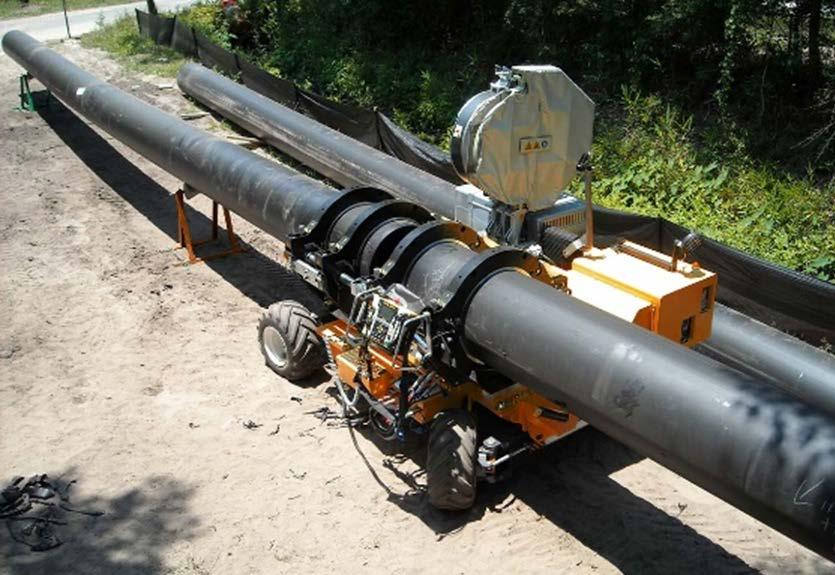
Butt welding and electrofusion welding –similarities and differences
Mechanical fittings are typically used to join pipe up to 125 mm diameter. For pipes above this size, butt and electrofusion welding are the common joining methods. In the butt and electrofusion processes, the surfaces to be welded are held together and heated to a molten state. On cooling, the molecular structures of the pipe and fitting materials entangle with one another until at ambient temperature they become completely enmeshed at the welded surfaces and form a homogenous or single material.
Butt welding is often the preferred joining method because modern machinery automates and simplifies the welding process. Butt welding’s limitation is that the machinery can be heavy and may be unable to be used in restricted or tight spaces.
Electrofusion’s advantages are that a variety of fitting types, such as saddles, tees, elbows and transitions, that can be used to connect to, from and between pipes.
Electrofusion fittings are compact, lightweight and can be installed in tight spaces, deep trenches or on sloping terrain and the installation equipment is lightweight and portable.
Electrofusion welding basics
There are challenges associated with both joining methods; however, this article will focus on electrofusion.
Electrofusion fittings are manufactured by injection moulding – each fitting is essentially identical to the next. In contrast, PE pipe is manufactured in an extrusion process –manufacturers do their best to ensure consistency, but small changes in the outside diameter, shape and other physical characteristics can occur. This means one run of pipe may be very close to, but not identical to, another run of pipe. For

48
Butt welding equipment (left) and electrofusion welding equipment (right).
this reason, the pipe surface must be prepared carefully before electrofusion can be carried out.
The Plastics Industry Pipe Association of Australia (PIPA) produces a guideline for electrofusion installation called POP001 (free to download at www.pipa.com/technical). Registered training organisations such as Irrigation Australia also offer a nationally accredited course called PMBWELD302E, and manufacturers such as Plasson offer free training on the installation process.
Four steps to pipework that lasts 100 years Without going into great detail, this article provides an outline of the steps that must be carried out when performing electrofusion. Proficient installers may speed up each installation step, but they will never miss a step out.
1. Peeling. At manufacture, pipe leaving the extruder is hot (around 200 ºC). At this temperature, oxygen in the air reacts with hot PE and leaves a thin layer of oxidised material on the surface of the newly made pipe. This layer acts as a barrier to entanglement between the pipe and fitting materials during welding and is the greatest cause of weld failures we see in the industry. Historically, hand scrapers have been used to remove this layer; however, they are ineffective at removing the correct thickness across the weld area, and missed regions can result in weak welds and premature joint failure.
Mechanical peelers are the best tools to remove a consistent depth of peel across the weld area. They are also very fast to use. While they will cost more than a hand scraper from the local hardware store, they are a key component in an installation that will last decades.
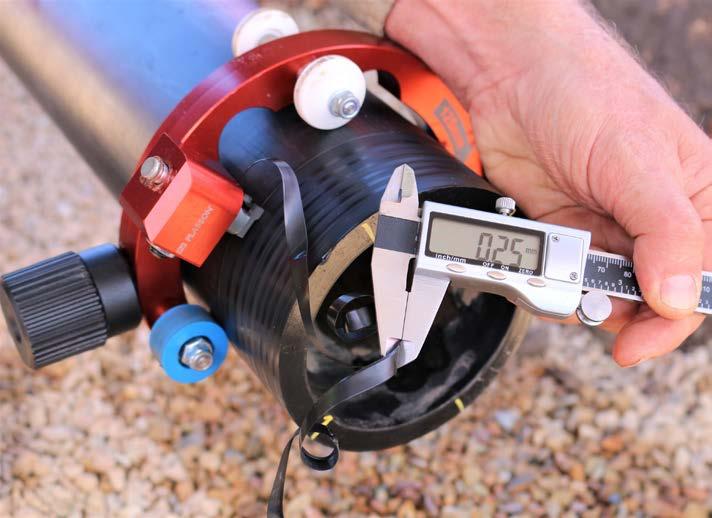
2. Ovality. To enable manufacturers to produce long runs of pipe for delivery to farms, PE pipe under 125 mm diameter is often coiled. As the hot pipe leaves the extruder and enters the coiling unit, it becomes oval. Installing round electrofusion fittings on oval pipe results in gaps between the weld surfaces. The fitting has a limited ability to fill the gap with molten plastic and excessive gaps reduce molecular entanglement and can result in weakened joints with reduced joint lifespans.
POP001 includes a calculation that determines if pipe is excessively oval. If pipe exceeds a certain limit, re-rounding tools must be used.

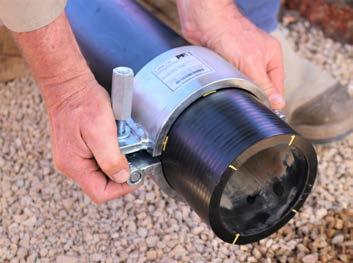
3. Cleaning. The expression “Cleanliness is next to godliness” also applies to electrofusion welding. One of the last steps before beginning the weld is inserting the fitting onto the pipe surface. At this time, alcohol-impregnated welding wipes are used to clean dust, dirt, sweat and sunscreen from the surfaces to be welded. Rags with alcohol sprayed on them are not recommended because experience shows that the same rag gets used over and over, accumulating more dirt and contaminants which then wind up back on the pipe surface.
Wipes on the other hand are fresh and have the correct amount of alcohol in them. They are also made from special fabrics – unlike cleaning rags, which can contain dyes and moisturisers.
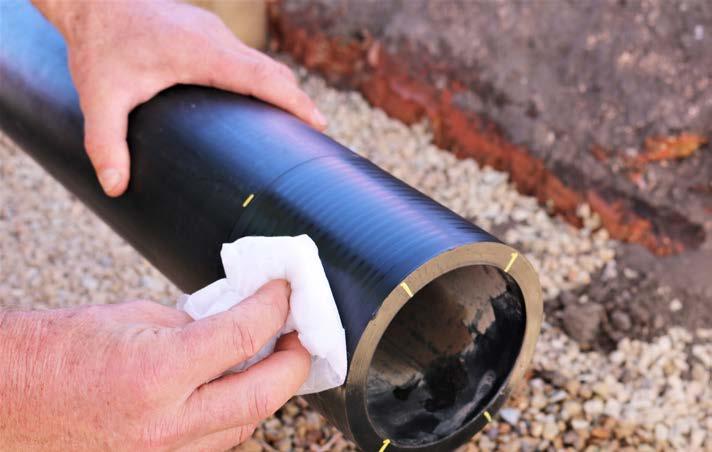
WINTER 2024 49
While mechanical peelers will cost more than a hand scraper from the local hardware store, they are a key component in an installation that will last decades.
The Plastic Pipe Industry Association’s guideline for electrofusion installation includes a calculation that determines if pipe is excessively oval (left). If pipe exceeds a certain limit, re-rounding tools must be used (right).
Use alcohol-impregnated welding wipes to clean surfaces to be joined.
CONTRACTORS’ CORNER
4. Alignment. Coiled pipe is permanently curved, which creates misalignment and gaps between the pipe and fitting weld surfaces. The weld surfaces should be as close to one another as possible. Alignment clamps are used to eliminate gaps and to hold the surfaces in close contact during welding.
It’s important to mention that the cool-down period is just as important as the welding period. During welding, the pressurised molten materials intermingle with one another. On cooling, the molecular components in the pipe and fitting become entangled and locked together. Moving joints during the cool-down time can undermine the entanglement process.

Learn electrofusion and butt welding
Irrigation Australia runs short courses in electrofusion and butt welding, which includes two years’ certification.
You will learn:
• about polyethylene pipe products and fitting relevant to butt and electrofusion welding requirements
• how to identify materials being used in the installation as compatible for welding using electrofusion welding methods
• to calculate appropriate welding parameters
• how to weld through hands-on practice
• how to maintain and calibrate welding equipment
At the end of your one- or two-day course, you will have the skills and knowledge required to weld polyethylene plastic pipes using electrofusion, and a nationally recognised Statement of Attainment.
Find out more here: Electrofusion & Butt Welding (irrigationaustralia.com.au)
Understand the guidelines
Fortunately, installers don’t have to spend much time pondering these steps because the installation parameters are laid out in PIPA POP001 (www.pipa.com.au/technical/ pop-guidelines)
Installation guidelines are tricky to write, and although POPO001 is far from perfect, installers who read and understand it will find their installations run more smoothly and their grandchildren will be still admiring their installation handiwork in 100 years’ time.
AROUND INDUSTRY
ENVIRADA ACQUISITION OF WATER DYNAMICS
Water monitoring company Envirada has acquired irrigation company Water Dynamics. This acquisition, completed on 2 April 2024 marks a significant step for Water Dynamics, promising enhanced industry focus, increased investment, and access to Envirada’s advanced technology.
Scott McLennan, CEO of Water Dynamics, expressed enthusiasm for the transition, highlighting the growth and success under Questas Group and looking forward to new opportunities with Envirada. He emphasised collaboration with a partner dedicated to advancing water technologies and investing in water, agriculture, and government services.
Envirada's CEO, Wolfgang Pruckner, echoed this excitement, noting that the acquisition aligns with Envirada's commitment to sustainability and innovation in the water management industry. He praised Water Dynamics' dedication to agricultural excellence and looked forward to collaborative efforts to drive innovation in water control and positively impact global communities.
Water Dynamics has relocated its headquarters to Level 1, 10/65 York Street, Sydney, while maintaining all branch locations. This acquisition strengthens both companies' positions and underscores their commitment to growth and innovation. Both teams are excited about the future opportunities this partnership will bring.
Information. Find out more at the Water Dynamics website or the Envirada website
50
The cool-down time is just as important as the welding itself. Pipes should not be moved during this process.
Mark Habel, Plasson Australia
MEET THE TEAM






DAVE CAMERON Chief Executive Officer
IAL Brisbane Office
Dave.cameron@irrigation.org.au

NAOMI CARRAGHER
Business Administration Manager/ Company Secretary IAL Brisbane Office
Naomi.carragher@irrigation.org.au
MARIKE FRONEMAN Accountant IAL Brisbane Office
Marike.froneman@irrigation.org.au


REBECCA NEW Membership Manager IAL Perth Office
Rebecca.new@irrigation.org.au

STUART ALEXANDER
Senior Trainer & Assessor IAL Brisbane Office
Stuart.alexander@irrigation.org.au
SAM O'BRIEN
Business Manager - Training IAL Brisbane Office sam.obrien@irrigation.org.au

AMY HALDANE RTO Compliance Officer - Training IAL Brisbane Office amy.haldane@irrigation.org.au
MADDISON COWARD Communications Coordinator IAL Brisbane Office Maddison.coward@irrigation.org.au
ASHLEIGH LANG Training and Certification Administrator IAL Brisbane Office Ashleigh.lang@irrigation.org.au
FLORENCE EDWARDS Office Junior Administrator IAL Brisbane Office florence.edwards@irrigation.org.au
ABBY Mc CORRISTON Office Junior Administrator IAL Perth Office abby.mccorriston@irrigation.org.au
IRRIGATION AUSTRALIA OFFICE
PO Box 13, Cannon Hill, Queensland 4170
T 07 3517 4000
W www.irrigationaustralia.com.au
CEO: Dave Cameron E info@irrigation.org.au
EDITORIAL
Editor | EVE WHITE E evewhiteediting@gmail.com
ADVERTISING
BCB Media | Managing Director | Brian Rault T 0411 354 050 E brian.rault@bcbmedia.com.au
DESIGN & PRODUCTION
Bubble Creative | Director | Annette Epifanidis T 0416 087 412 E annette@bubblecreative.com.au
TERMS & CONDITIONS
Advertising in this journal is managed by BCB Media on behalf of Irrigation Australia Limited. All contact with businesses and organisations about advertising is made by BCB Media staff, who must identify themselves and the fact that they work for BCB Media on behalf of the IAL.
Advertising enquiries should be directed to BCB Media.
No special consideration will be given to any advertisers as far as editorial content or front cover material is concerned. Decisions about editorial content and the front cover are the prerogative of the editor and the National Board of the IAL.
Irrigation Australia Limited takes no responsibility for the technical accuracy of article content.






















































 Graphic supplied by Melbourne Water
Graphic supplied by Melbourne Water









































































































